#Best International Narrative Feature
Text
I think Brennan did something interesting with the Porter and Gorgug scene in the last episode. Porter is by all appearances a competent Barbarian teacher. He understands the role of Rage and its mechanical combat benefits, and he even recognizes how Gorgug uses Rage to protect those he cares about. But he doesn't understand how multiclassing into a caster fits into that framework.
And it's true! In 5e you can't cast or concentrate on spells in a Rage. But-- Artificers work a little different than other casters! Alchemist Elixirs and Arcane Cannons aren't technically spells. Arcane Armor just works. And so does the Steel Defender.
Of any caster I think the Artificer is probably the best-suited to multiclass Barbarian because their key subclass features are largely not spells. But it also runs into the problem of requiring multiple high stats. Barbarians already want high STR and CON, and Artificers need INT for their spells and spell saves.
And so there's this narrative tension here. Brennan the DM obviously wants to let his player have fun with the character build-- embracing the creative artificer side of himself is a great character moment for Gorgug, bearer of the tin flower. Someone who has always channeled Rage to protect those he cares about but who has also been called to create and preserve beauty.
And yet mechanically, it's a difficult build. We didn't see Gorgug cast anything in the Night Yorb battle, as far as I recall? And in-universe, classes are a formally recognized thing that require approval. But Gorgug can't be the kind of Barbarian that Porter wants him to be. So he has to show that he can be a different kind of Barbarian-- one whose magic integrates and synergizes with his Rage rather than opposing it.
We see Gorgug still insecure about his homunculus and about the solar lasso, even though these are objectively impressive feats. So it's not a skill issue but an internal conflict-- it's only once Gorgug reconciles and synthesizes his magic with his Barbarian side that the in-world powers that be will recognize him for all of who he is.
#fantasy high#fantasy high junior year#dimension 20#dimension 20 spoilers#fantasy high junior year spoilers#gorgug thistlespring#and just to be totally clear this is not a criticism of zac the player! this move made sense for the character#and it set up this great internal conflict for the character to navigate#i'm just remarking on how brennan and zac are using the rules of the system to produce an in-world conflict for the character#which is super fascinating
1K notes
·
View notes
Text
Imagine that a century or two from now, the eastern half of the United States is conquered by the Canadian Empire, its intelligentsia deported, its land colonized by Canadian immigrants, and its remaining people mostly gradually absorbed into a Neo-Canadian identity. The West reorganizes, developing a new political and cultural center, and comes to regard itself as the "true" United States, with the remnant culture of the East (by now much changed by Canadian rule) as representing an unchanged tradition stretching back to the time of George Washington. The holdout western half is subsequently conquered by the Reformed Mexican Empire, and while most of the population remains in situ, its elite is taken to Mexico City. There, for three or four generations, they do their best to maintain their distinct American identity, focusing on the American "civil religion," the distinctive political ideals and cultural features that mark them out as Americans, and come up with a new way of interpreting their history that allows America to be a perennial idea, something not directly physically tied to the territory of the United States, which no longer exists. They compose a body of historical works based on Washington Irving's rather fabulistic approach to early American history, the half-remembered popular versions of the stories of Columbus and the Pilgrims, the First Thanksgiving, even the Revolutionary War. They don't have access to the original texts anymore--let's say this is all taking place in a post-Collapse North America where long-range travel and communication is difficult and a lot of history has been lost--but they do their best. They append to these books, or include in their text, of history a copy of the Constitution, big chunks of the United States Code, and Robert's Rules of Order.
Subsequently, the Empire of Gran Columbia invades, conquers southern and central Mexico, and its Emperor lets the captive Americans go home. They return north, mostly to California, find that the version of American history and civics that is remembered there isn't the same as the version they have (not that the Californian one is correct--the Mexican Empire has suppressed English-language education and high culture in its Aztlani provinces), and set about reforming and reorganizing the Western States (as they're now called) to be more in line with the forms they brought back from the exile. In the meantime, other bits of important literature start being kept in libraries next to copies of the received histories: some bits of early American literature, like Hawthorne, the Song of Hiawatha, some highly abridged Herman Melville, Thomas Paine--heck, even some John Locke, and quotes or fragments from Shakespeare. Some traditionalists now argue the capital of the United States has always been located in San Francisco, and that Washington, D.C. only because the capital later, under the influence of Eastern heretics.
In the following centuries, the Western States retain their independence for a time, but eventually become a secondary battleground for a lot of other empires--the Mexicans, the Canadians, the Pan-Pacific Federation, and so forth. American culture remains distinctive, insulted in part by its unique traditions, though now everybody speaks Future Spanish, and only learns English to read the old texts. In this period additional material, including later compositions, continues to accrete, forming a distinct body of sacred American scripture, although it does not exist in a single canonical form. Attempts to reconcile distinct sources, like more literal and historically-grounded accounts versus the simplified narratives of figures like Irving, produce hybrid texts that sometimes are full of internal conflicts.
Oh, and through all this, some institutions of American government like the Supreme Court still function, although their rulings only apply to Americans, and there isn't much in the way of a federal bureaucracy.
Finally the Great and Sublime Brazilian Potentate conquers most of the Americas, sets up an American client state that roughly coincides with the heartland of the old Western States (California, Oregon, most of Washington and Nevada), and allows the Americans to elect their own President (subject, of course, to Brazilian approval). During this period, an apocalyptic street preacher from Los Angeles claims to have inherited the authority and power of George Washington, and is executed by the Brazilians; his later followers point to the prophecies of Emperor Norton, and out-of-context bits of a Quebecois translation of Moby-Dick and some Mark Twain stories to say no, really, he was George Washington. Inexplicably, a version of this religion becomes the dominant faith of the Brazilian Empire before it collapses. But long before then the American state in California fails, crushed when it tries to revolt against Brazilian rule; the remnant Easterners likewise dwindle down to only a few hundred souls living in a village in Alexandria, Virginia. Centuries from now, as the descendants of the descendants of the Brazilians colonize Mars, they will point to the sacred Americanist scriptures, the Neo-Americanist narratives of their prophet's life, and the letters written by the early leaders of Neo-Americanism, and say, "all of this was written by the spirit of George Washington, and is free from contradictions." Meanwhile the remnant Americanists, who have been writing about Americanism and how it applies to their everyday lives in the centuries since, and whose commentary has formed around the copies of the last editions of the U.S. Supreme Court Reporter (SCOTUS managed to outlast the final American state by a hundred years or so) plus the thoughts of the remaining Americanist community in Mexico, continue to regard their traditions as the unbroken and unaltered practice of American culture, politics, and ideals as they existed since the Revolutionary War.
This is, as far as I can tell, approximately how the Bible was composed.
1K notes
·
View notes
Text
Plurality in Slay the Princess: Part 1
[pt: Plurality in Slay the Princess: Part 1]
Imagine you're standing facing the unknown, and then a little internal voice begins narrating everything you see.
[The Narrator] "You're on a path in the woods. And at the end of that path, is a cabin. And in the basement of that cabin, is a princess. You're here to slay her; if you don't, it will be the end of the world."

He seems pretty biased.
One of the best indie games to come out in 2023 was Slay the Princess, an indie horror/romance visual novel featuring your player character and the being he's meant to slay, known simply as The Princess. However, you're not alone, in more ways than one- both your player character and the Princess display clear aspects of plurality - aka, multiple identities residing within/utilizing a singular physical body. This can take many forms in real life, from disordered to non-disordered variants, and a good few of them are prominently recognized in this visceral narrative experience.
After the read-more will be some spoilers from the various choices you can make throughout the early game- so while this is part 1, there will be no endgame spoilers yet! It'll start off with Chapter 1 and go deeper from there. If you're intending on playing the game, we HIGHLY recommend you play only after reading Chapter 1 information, or only after this part 1 at most! It's best experienced blind as possible, and trigger warnings are present upon opening the game. This analysis took a while to write, so please consider reblogging if you enjoy!
...
Right from the beginning, the plural undertones of the story are clearly apparent. Once the Narrator stops speaking, you as the one controlling the body are able to communicate by asking various questions directly to the Narrator to press upon, enthuse over, or counter his point. The Narrator is speaking to you mentally, but is not you.
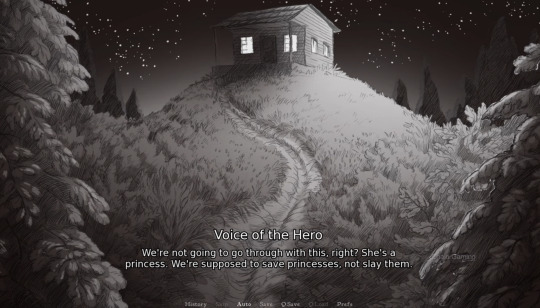
If you continue on the path to the cabin, you're presented with someone else speaking to you internally, titled as "The Voice of the Hero". The Narrator quickly responds with "Ignore him. He doesn't know what he's talking about." This situation tells us a lot of interesting things! First off, the Hero defers to the pronoun "we" - as he's clearly responding to the Narrator's direction, the other individual in this situation must be the controller of the body. The Narrator reinforces this concept by talking directly to you, telling you to ignore the Hero. So right off the bat, there are three people in this body- the Host, whom is being controlled by the player, the Narrator, and the Voice of the Hero. They stay with you throughout (most of) the entire game, so even without much happening, the main character is very blatantly plural. The only thing we can tell about them so far is that they're a polyconscious system, wherein each member displays their own individual consciousnesses rather than sharing one, and can all perceive the world using separate streams of thought.
Let's say you head to the cabin, speak to the Princess, and don't even bother taking the pristine blade meant to slay her, as you're intent on saving her. You speak to her with options using "quotation marks" to indicate vocal speech rather than how you've been thinking to the other members of your system, and you free her from her bindings. Just as you're walking up the stairs, the Narrator decides to try and impose his decision instead, and save the world by using the arm of the body to raise the blade to her. Being in control of the body as a plural/system is called fronting, and oftentimes in intense circumstances, one member can "take" the front from another. This is what we see in the desperate Narrator, and the fact that the Hero expresses his frustration at the Narrator's actions at the same time indicates once again that the members of this system are polyconscious.
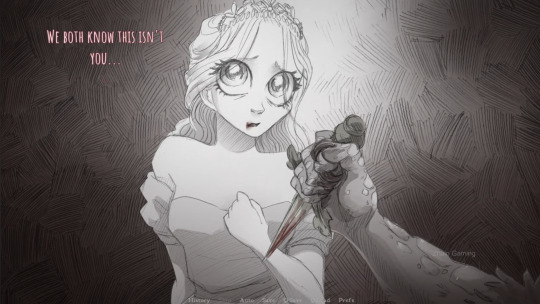
You resist the Narrator and warn the Princess, and she also notices and addresses the sudden shift in motivation. She then takes the blade, and uses it haplessly against you in self defense. Such is this end of Chapter 1; everything goes dark, and you die.
!!! CHAPTER 2+ SPOILERS BEGIN HERE !!!
[pt: !!! Chapter 2+ spoilers begin here !!!]
Chapter 2 is titled "The Damsel". When everything loads, you're back where you were before- the Narrator doesn't seem to remember you or what happened, but you and the Hero clearly do.

Not only that, but another character has joined the mix since your supposed death- The Voice of the Smitten loudly proclaims his love for the Princess and hatred for the Narrator. Plus, he says something unique- he mentioned "the four of us" foiling the Narrator's "assassination attempts". This four includes the Princess, the Smitten, the Hero, and the Host/player, establishing how everyone here perceives the others as separate entities. Plus, now that naming consistency with the others established, the Narrator, not labeled as a "voice", starts to stand out as something... Different, from the rest of you all.
But it's not just you that's changed; everything within the cabin looks different, and it's not only that.

The Princess has metamorphosized; the Damsel wears a new dress and crown, has a much more gentle and delicate disposition, and her voice sounds significantly higher pitched and kinder. Not only that, but her bone structure is physically thinner, as is addressed later in the route. She has inarguably become different in not only personality but appearance too. Additionally, while she recognizes you and your earlier confrontation, she uses the pronoun "I" to refer to both herself as the Damsel and herself as the Princess before. This is indicative of monoconscious systems, where members share an individual consciousness/train of thought and switching involves the feeling of one member "becoming" another in a smooth transition, and median systems, where members often feel like facets of an overarching identity rather than completely separate entities. We see more evidence to medianhood after the two of you escape, and the Damsel seems to be taken away by... Something. You find yourself presented with the Entity holding her gingerly.
"Something finds me in the Long Quiet and brings me the gift of a fragile vessel."
She cradles her and describes the vessels as "nerves and fibers to feel the worlds beyond. Perspectives to make my own", and the Damsel as "soft and delicate. You molded her to love you, and she'll make for a gentle heart." She words it as if they are the same, and yet different at the same time. You ask if she is the Princess, and she says this;

upon pressuring, she states that you're speaking in circles. "Does it matter where one thing begins and another ends?" This once again supports the fluid concept of median plurality. She is different, and yet she is the same. It's hard to tell the lines between one and the other, even though they both still distinctly exist. She asks you to "bring [her] more perspectives so [she] may be whole", wishing for the facets of herself to be returned to her via completing different routes of the game. Interestingly enough, it seems the Entity displays polyconsciousness during these segments, unlike the in-loop Princesses. In another route she mentions the Princess having a will pushing against her own, and at the end of your conversation she mentions one last thing;
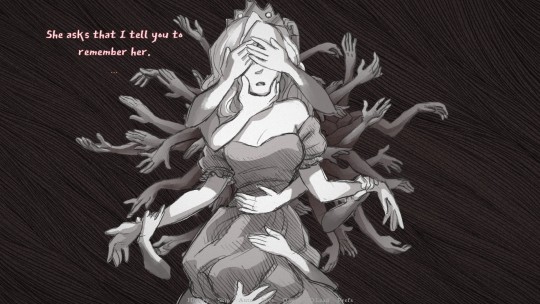
You're flung back to the beginning, with only the Hero and the Narrator at your side, and not a single memory ingame of what happened. You can't re-access old routes, so you have to choose to do something different the next time, to bring different parts of herself home to her.
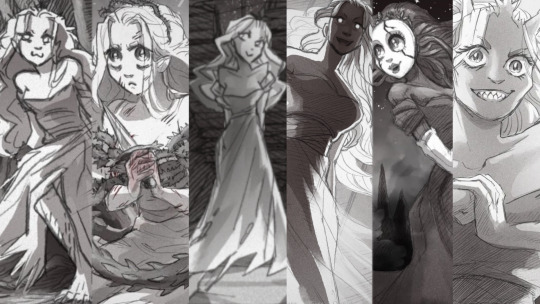
There are many different routes you can end up on, and the Princess will change in many different ways depending on your decisions. Let's go over some interesting notes on how the two's plurality presents over the course of the time loops.
- The Princess seems to be completely monoconscious when within the loops, sometimes acknowledging herself as different but never referring to her other facets as a separate perspective ("I/me", never "she" like the Entity refers to her vessels.) This rule is only broken by the Stranger route whom, where due to the world literally fracturing, had multiple perspectives shoved into a single one, and she refers to herselves as "we".
- The origin of new facets of the Princess seems to correlate directly with the reset of the world they're in, and we never see her looping forms change otherwise, meaning we can likely assume this to be their origin. While time loops aren't recorded to have happened in this universe, we can safely attribute some sort of metagenic origin to the Princess's median facets. The only other time we see her "change" other than after a reset is her disposition & voice upon the first time meeting her, depending on whether or not we take the pristine blade. This displays that the player character's actions directly affect the Princess's facets as well, however delving into that would get into endgame spoilers, so it'll be touched on in part 2.
- Due to the lack of evident amnesia, distress, or disorder expressed to be caused by her plurality (aside from the Stranger) it's safe to assume the Princess falls under the category of systems/plurals without a dissociative disorder such as DID, P-DID, OSDD1, and UDD.
- On the flipside, the Player's system shows quite a lot of distress and disorder, from the Broken and the Smitten attempting to kill the body to the Cold eager to harm it, as well as many different system members with specific jobs meant to help counteract or ease the negative circumstances of the previous loop. Additionally, during the Moment of Clarity chapter, the Host explicitly experiences amnesia of traumatic memories the other members remember everyone experiencing, displaying dissociative amnesia. It's likely this system falls under the category of plurals with a dissociative disorder such as DID, P-DID, OSDD1, and UDD.

- Many speculate the members of the Player character's system to be your past lives or iterations of you after your death, since for the most part, a new one appears every time the body dies. This would be known as a fenigenic/phoenigenic origin. However, there are a couple instances where this theory falls apart- for example, in the No Way Out route, the Player, Hero, Narrator, and Cheated are joined by both the Voice of the Contrarian and the Voice of the Broken at the same time; right after, the Hero states that this is your third time, meaning if the past life theory is true, there should be only two new members, not three. (The line between alive and dead gets fuzzy later in the route, but this one is cut and dry.) Instead, I propose the Player's system to be an adaptive system, ending up with new members whenever they must adapt their mindset drastically to the situation. The new members often tend to be a reflection of the body's actions during the last loop, which supports this concept as well.
- Routes such as No Way Out and The Adversary complicate these assessments. In No Way Out, every time you die you try something different, which results in a new system member every time. In The Adversary, you fight over and over again with the same determination, and The Stubborn remains as the only new member from the beginning the entire time. However, in both of these routes, the Princess stops changing form at all. Evidence once again shows itself that the Player Character's perception not only affects what the Princess will be, but what the results of his own changes will be as well.
- Another differentiation between you, the "voices", and the Narrator, aside from his lack of memory between loops and insistence that he's not the same person as other versions of him, is how they both treat and experience the Mirror. The Narrator is notably distinct in that he cannot see it during regular gameplay, and that once the world is replaced with it at the end of a route, he's no longer existent to perceive it. The ones labeled "voices" are able to see it and fear it instinctively- while they're different from the Narrator, even they disappear when you look in the mirror and speak to the Entity. Hypothetically, this could mean that you are to the Voices' perspectives as the Entity is to the Princess's. The Entity mentions that nothing but you and her come to the space where you speak.
- Upon meeting the Entity after the third time you bring her a vessel, she greets you with this line; "I am a growing chorus of contradiction. A mass of tides ebbing and flowing all at once in more directions than my attention can bear to hold. To look at any one is to shift them all into something new, and to look away is to reshape them yet again. All of me is changing, and yet the rest is still the same." This is an interesting perspective into her relationship with the vessels and how her overarching identity is affected by her medianhood.
- A case that deserves special mentioning is the route of the Spectre, after killing the Princess without hesitation in chapter 1 and then proceeding to kill yourself after. In Chapter 2, you're then presented with the option to let the Spectre possess you temporarily, giving her not only access to your body, but to your mind. For a brief while, she can hear and interact with all the others currently present with you- at the time, the Narrator, the Voice of the Hero, and the Voice of the Cold. Once she's within you, the Narrator can't even get out a full sentence before she comments, "So this is what it's like to be you, huh? Disembodied voice narrating your every move?" She addresses the Voices differently than the Narrator; "All these shards of broken glass on the floor... Are they also supposed to be you?" The Hero takes initial offense at this, saying that "I'm me, is what I am." The conversation continues to the Hero questioning the Narrator's existence, to which he responds, "You don't need to know what I am. You just need to know that I'm different than you. More important."
To this, the Princess answers, "So you're the one that pulled the strings and made me dead. I can tell you don't belong here. You're barely even there. Like the shape of something left behind. You're more of a... Memory, than a person." And then, "You're kind of like me, actually." What does she mean by that? Is he like a ghost? Something else? It'll be addressed in part 2, but clearly he's different from the rest.
- One of the most affirming dialogue options you can have with the Entity is after the fourth time you bring a Vessel to her, where you both speak about how your systems operate. You can ask her, "When you send me back, I'm not alone. There are voices that speak to me. Some of them are me, but one of them is something else. I call him The Narrator, and he wants me to kill you. Do you have a Narrator? Have the Vessels had one?" This is yet another hint that the Narrator is fundamentally different than the rest of the Player's system, making it clear that together they make up a mixed origin system. In response to your question, the Entity responds with this:

From this we get a few things. For one, the Princesses are referred to in the plural sense ("their minds"), enforcing the separation between them. However, she goes on to describe them existing and constantly metamorphosising into something new, basically confirming the concept of monoconsciousness within the Princesses themselves.
....
From all this, we've drawn a lot of conclusions about the plurality of the Player character and the Princess/Entity from Slay the Princess! Such depth of plural experiences is extremely rare in any media, and this one exemplifies it very well, balancing both personhood and parts-based conceptualizations in its depiction. In part 2 we'll go over how the endgame and its philosophy applies to these concepts, as well as the revelations about the characters involved. It's wonderful to have such vibrant and unique plural representation in a video game; thank you for reading this disambiguation!
#slay the princess#stp princess#stp analysis#pluralgang#plural community#plurality#plural system#system community#pluralpunk#plural headcanons#stp the princess#stp the long quiet#stp the hero#the narrator stp#the shifting mound#the long quiet#media analysis#character analysis#slay the princess analysis#adaptive system#monoconscious#mixed origin system#sysmeds dni#exclusionists dni#didosdd#did osdd#disordered system
332 notes
·
View notes
Text
When writing both original fiction and fanfiction, it's my personal preference and style to remind people who characters are in the narration when I feel it might be needed. It's especially handy when bringing OCs into a fanfiction. Example: "The person calling out to them was [Character's Name Here], the baker they had met earlier that morning." This quirk of narration often reads to me as the POV character internally reminding themselves who someone is.
Sometimes, a character is quite bad with names or wasn't given one, which is where it's handy to refer to this other character by a fixed epithet. Example: "The person calling out to them was the square-faced man from yesterday, who had given them those bad directions." OR: "The person calling out to them was the mayor's daughter." This reads to me as though the POV character is distinguishing people by a particular feature or remembers them by their relationship to someone else, which is a common way to remember people, until their own name becomes more fixed in your mind.
I also think it's important to keep an epithet / title the same across a scene. Epithets are best used, in my opinion, when that particular feature or quality is actually relevant. It's a little weird for a POV character to suddenly think of their own husband as "the tall man" unless his height is suddenly important in some way, and it might confuse the audience into thinking another person is in the room. If a character doesn't have a name, then "the square-faced man" or "the mayor's daughter" effectively becomes their name, and it's confusing to have a character's name change too much with every other paragraph. (It would be fine to also refer to "the mayor's daughter" as "the girl" or "the young woman" as long as there aren't any other nameless girls speaking in the scene.) Keeping the same title allows it to blend in in the same way that the word "said" does, rather than break up the flow of a scene.
Not every person or character is bad with names and remembering people, of course, or is inclined to give them funny little internal titles. There are people who are very good at names. There are tricks to use to get yourself to memorize names as you're introduced to someone. Narrative styles are going to be different by author and by the current POV character. (Sometimes, you might want the audience to be confused and disoriented!)
In fact, thinking about how different characters think about each other is one of my favorite starting places for crafting a perspective voice. A single character might be referred to in the narration as "His Majesty" by one character, "my husband" by another character, "the king" by a third character, "the usurper" by a fourth character, and "Dad" by a fifth. The name that a character calls someone else by will often say a lot about their relationship and their opinion of that other person. If the prince appears to think of his father as "the king" rather than "Father", that implies something about their relationship.
But back to introducing character names, you as an author, in my experience as a writer and reader, generally can't rely on the audience to easily recall very minor character names unless they're very distinct or the character was introduced in a particularly memorable way. Like, if you introduce a character as the protagonist's best friend, Mary, and immediately start refering to her as Mary because it's followed by a conversation between the protagonist and Mary, that's fair! It's reasonable to expect the audience to just learn Mary's name here! But then if Mary disappears after Chapter 1 and doesn't show up again until Chapter 10, I think it's reasonable to subtly reintroduce her to the audience again. Example: "It was Mary smiling at me from the doorway, and I jumped up to hug my best friend immediately."
Like, there's no one way that you have to refer to characters and introduce them and reintroduce them, of course. Characters have different levels of importance and sometimes we don't really need to know who they are. Sometimes, an author wants an audience to feel grounded, to recognize people, and sometimes they want their audience to feel lost and scared. It's all situational. Style is a thing.
But because it's all situational, this is something I like thinking about and I think it's something worth studying when you're reading original fiction. It's interesting to pay attention to how characters enter and exit scenes in different forms of media, and how the narrator introduces them and how other characters greet them aloud. (Shakespeare comes to mind as a neat thing to look at, to see how theatre does it. Comic books and films and visual media will do it differently to a text-only story.) The audience doesn't have the background that you, the author, carry around in your head all of the time, and you often need to give them a helping hand in keeping your cast of characters straight. Even in fanfiction, without including OCs, not everyone in the audience has the whole canonical cast perfectively memorized, and not every character in any given cast actually knows every other character! It's not just OCs who need introductions, whether those introductions happen subtly or a character enters the story with a bang.
Kind of another side note:
One of my favorite character introductions comes from the book "The Princess Bride", in which Princess Buttercup is kidnapped by three men who are referred to only as "the Spaniard", "the Turk", and "the Sicilian". You don't know their names for quite some time. Buttercup doesn't know these people.
You only learn the Spaniard's name when the Sicilian leaves him at the top of a cliff, tasking him the Spaniard fighting and killing "the Man in Black" who is pursuing their kidnapping. When the Spaniard is about to fight someone to the death, the book pauses to tell you that his name is Inigo Montoya, and then there is an ENTIRE CHAPTER dedicated to Inigo Montoya's long and tragic backstory, in which you learn about his decades-long quest to find the six-fingered man who murdered his father. And then the book abruptly dumps you the audience back out onto that cliff, where Inigo (no longer just "the Spaniard" and no longer just some random kidnapping thug) is about to fight for his life.
I think it's a terribly fun piece of whiplash that suits the comedic style of the book really well. (The book is a little different to the movie and there are things about it that I don't like, the movie gets across a level of a sincerity and love through the acting that the book misses in places, but there are lots of really funny elements to the book that the movie sadly couldn't cover.) The transformation from "the Spaniard" into "Inigo Montoya" is really neat to me.
126 notes
·
View notes
Text
On God of War and "canon" in Norse mythology
Playing God of War: Ragnarök and reading writing about it reminds me of something a lot of people have trouble internalizing about Norse myth, which is is that
The vast, overwhelming majority of Norse mythology is lost
and
There is no "canon" in Norse mythology
The concept of "canon" in religion is, at least in the west, very much a Christian thing (yes, it's also a feature of other religions). The idea that there is an authorized, central, divinely ordained, "official" central set of facts which are true, and everything else is fanfiction at best or heresy at worst.
And this is something we've taken with us into our general media criticism, hundreds of thousands of words exchanged between people debating which parts of Star Wars or the MCU are canon, or endlessly cycling through interpretations of what parts of Tolkien's mythos apply to each part of the Lord of the Rings or the Hobbit. I've participated in those discussions, and they can be a lot of fun, but it's worth remembering that this is only one of multiple ways to approach writing and narrative.
Norse mythology has no canon. There is no set of texts that have been declared by any central authority to be "the truth" of the Allfather, or the most correct depiction of Thor. Even in its own time, before its suppression by Christianity, Viking-age sailors, farmers and warriors would not have understood their religious practise as bounded by a finite and defined set of stories. It was an oral tradition, transmitted by telling and re-telling.
Your skjald knows some stories of the gods, maybe the guy the next town over knows some different ones, and maybe you go on a trading journey with a guy from Norway who knows completely different stories and you take those home with you where they become a part of the local rotation.
The primary sources for most Norse mythology (and certainly for God of War: Ragnarök) are the Prose Edda and Poetic Edda, two collections of texts compiled in the 13th century in Iceland by Snorri Sturluson, a Christian poet and politician, as well as possibly other contributors at the same time.
They are limited by their geography, consisting only of those stories that survived in Iceland, and limited by their time period. The Viking Age is generally considered to have ended around 1050 CE, so Sturluson was compiling these stories two hundred years after the time when Norse paganism would have been the dominant religious practise in Scandinavia or indeed Iceland.
We have other sources than the Eddas, of course, but they are painfully limited: Runestones and archeological artifacts, as well as stories told about the Vikings by people who weren't them, which obviously comes with a lot of biases. The Viking-era Scandinavians themselves simply didn't leave any substantial body of written sources that survived.
Sturluson being a Christian, writing for Christian audiences, also introduces a lot of suspicion of tampering. He might have had incentive to avoid recording certain stories, for fear of being accused of spreading heresy, and he may have edited or altered aspects of the stories he did record to make them palatable to his audience, or to serve his own political purposes. This, of course, is a concern with any author writing anything ever, but since Sturluson is quite literally our only source for so many of these stories, it is impossible to check his work against competing narratives.
The consequence of all of this is that the vast majority of Norse mythology is lost. We do not know the vast majority of what that old religious practise was, we do not know the vast majority of its stories. This was a set of beliefs and stories told and transmitted across populations ranging from what is now the inland plains of Germany to the heights of the mountains of Norway to the shores and harbors of Denmark to parts of modern day Russia. These disparate populations would have had an absolutely enormous range of shared and local religious practises, they would have emphasized and cared about different gods, they would have absorbed and incorporated stories from neighboring religious groups.
This has a couple of consequences. For one thing, the whiny pissbabies crying about Angrboða being portrayed as a person of color in God of War: Ragnarök because "there were no black people in Norse mythology!" are, indeed, full of piss and expired baby oil. They don't know that, because nobody knows that.
Viking sailors made it as far as Constantinople and old Norse was once spoken in parts of Crimea. They even managed to make it across the goddamn Atlantic to found a settlement in Newfoundland, so the idea that old Norse peoples wouldn't know what a person of color is or tell stories about them is just absurd on the face of it. We have no direct evidence that they told stories about gods of color, but to look at the tiny snapshot provided by one Christian poet writing for a Christian audience in Iceland two hundred years after the Christianization of Scandinavia and confidently concluding that people of color couldn't possibly have existed in the Norse imagination is like finding the Q key off a keyboard lying on the ground and concluding there can be no such thing as vowels or the letter L.
The tiny sliver of Norse mythology that has survived to the modern day should to a modern reader be a prompt to imagine the vast possibility of what has been lost, not a reason to reduce the entire culture of my ancestors to whatever bits that were left by the time some dude in Iceland found it interesting and convenient to write them down.
Which leads us on to the other interesting consequence of the facts of Norse mythology.
It is an oral tradition, with no central canon and no central authority, whose religious practises were local and varied, whose stories were designed to be shared and picked up by whoever finds them compelling. Which means that any story we tell, now, about the gods that we find compelling is every bit as "canon" as anything that survives in the Eddas.
Which is to say: not canon at all, unless you decide to believe in it. Or, hell, even if you just find it enjoyable.
God of War: Ragnarök is as canon as Neil Gaiman's Norse Mythology is as canon as Jul i Valhal that ran on Danish TV in 2005 is as canon as the MCU Thor, is as canon as the Prose Edda, is as canon as the half-remembered re-telling of Norse myth I heard from my Danish teacher in class in 1998.
It is often very difficult for a lot of modern audiences to free themselves from the idea of "canon." We seem to instinctively want a certain set of stories to be "the real ones," a certain narrative to be the "official" one, and set adrift without that sense of central authority to guide us, a lot of people exhibit what I would call an almost resentful anxiety. If none of it is definitely true, then what is even the point of any of it? If you can't know for sure which story is the most real, then all of it must be meaningless!
And yeah. It's easy to feel that way. We live in the Age of Canon, the era of the cinematic universe and the franchise, the epoch of copyright. But that is only one way to understand stories and narrative.
If you listen to the stories of the old gods, whether out of the Eddas or re-told in pop culture, and you take some of that with you, and you pass the good bits on to someone else, then you are participating in the oldest and most sacred tradition of Norse mythology. These stories do not belong to any one author (especially not the goddamn Mouse!) or even to any one people. They were telling stories of Thor along the rivers of Russia a thousand years ago, Viking sailors scratched their names in runes in the Hagia Sophia, Islamic artifacts have been found in Viking burials. Those who look at the tradition of my ancestors and feel compelled to do enclosure around them are fools and charlatans, fearful and small-minded.
Our stories are monopolized these days by capital. Canon to them is a tool of enclosure, a way to shut people out of participating in the modern mythology they are trying to build, except with their permission and profit in mind. But there is another way.
Listen to the stories and pass them on. The story you believe in won't be the one everyone likes, and the version you tell won't be the same version someone else passes on from you. But every telling takes the soul of the teller with it, and the stories we weave together in communal tradition become a picture of every storyteller who has contributed to them. And you spite the fucking Mouse.
#tb essay#god of war#gow ragnarok#norse mythology#norse gods#history#prose edda#poetic edda#loki#thor#odin#angrboða
1K notes
·
View notes
Note
Hi Mike, how was Tribeca?
It was fantastic.
For those who don't know, I was lucky enough to be invited to sit on the US Narrative Feature Jury at this year's Tribeca Festival. I just got back yesterday from ten days in Manhattan.
I found the whole thing to be absolutely rejuvenating.

Our category had five jurors: myself, Zoey Deutsch, Stephanie Hsu, Tommy Oliver, and Ramin Bahrani.

Kate was also on a jury - she was on the International Feature Jury (which included Brendan Fraser and Zazie Beets) so that meant we spent the week seeing different movies. We'd pass each other on our way to different screenings, sometimes in the lobby of the theater, and then meet up for dinner or a party and get to tell each other about the awesome movies we saw that day.
It was overwhelming to start with. At the Opening Night reception, we met Robert DeNiro, and we saw Martin Scorcese and Matt Damon (we were way too timid to introduce ourselves). I did manage to introduce myself to Kenneth Lonergan, who has made some of my all-time favorite movies (You Can Count on Me is one of the best movies I've ever seen), and the great Chazz Palminteri (I got to tell him how much I absolute adore A Bronx Tale). I also spent a fair amount of time chatting with Peter Coyote, who was incredibly kind and funny. We chatted a lot about Ken Burns.




After that, we went to the Opening Night film, a terrific documentary called Kiss the Future. We walked the red carpet (something I'm never quite comfortable with, but luckily Kate is a natural) and we saw the movie with a packed house. It was a beautiful film and really started everything off on an amazing foot.

And then the judging started. I got to watch all of the movies in my category in the theater, with audiences. A car would pick me up and take me to the screening. At my busiest, I saw three movies in one day, but it was usually two.
I made it a point not to know anything about the movies before I saw them - sometimes I went in without knowing the title. And I can't overstate how amazing it was to see these independent films with an audience, in a theater, instead of streaming. Having spent the better part of the last five years watching this primarily at home, I was shocked at how inspiring and energizing it was to sit in a theater with a crowd over, and over, and over again. I've never seen this many movies in a theater in such a short time, and I LOVED it.
I didn't only see movies that were in my category, though. I also made sure I saw other films at the festival that I wasn't judging - including Downtown Owl, the directorial debut of my friends Hamish Linklater and Lily Rabe.


I made a point to go to the premiere of Suitable Flesh, starring the amazing Barbara Crampton and Heather Graham, and produced by my old friends Joe Wicker and Morgan Peter Brown from the Absentia Days.


And it wasn't all movies, either - I also got to moderate a chat with the brilliant Sam Lake about his upcoming Alan Wake 2 release. Sam was a joy to spend time with, and we had a lot to talk about.
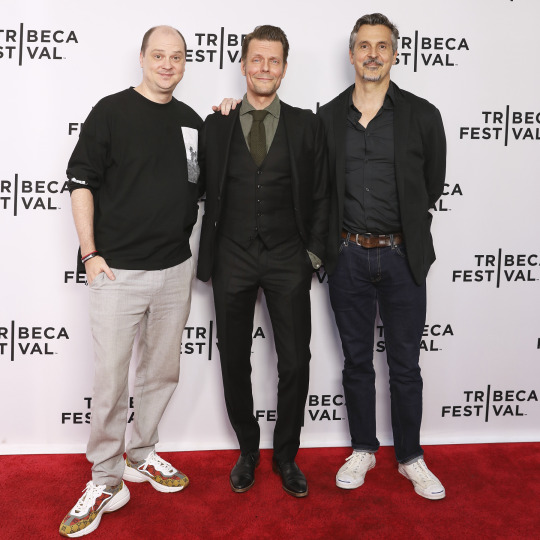

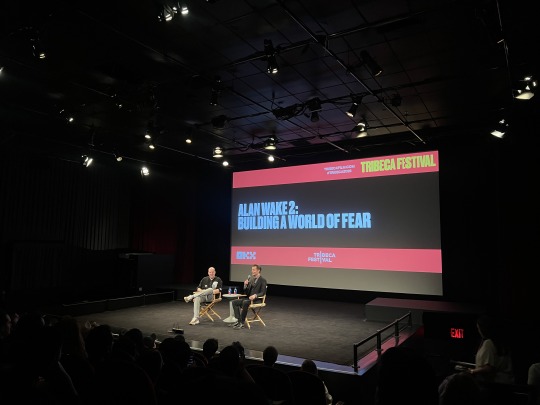
And my friend and colleague Justina Ireland traveled up to NY to moderate a Master Class where a theater full of people listened to me ramble about horror movies for an hour.
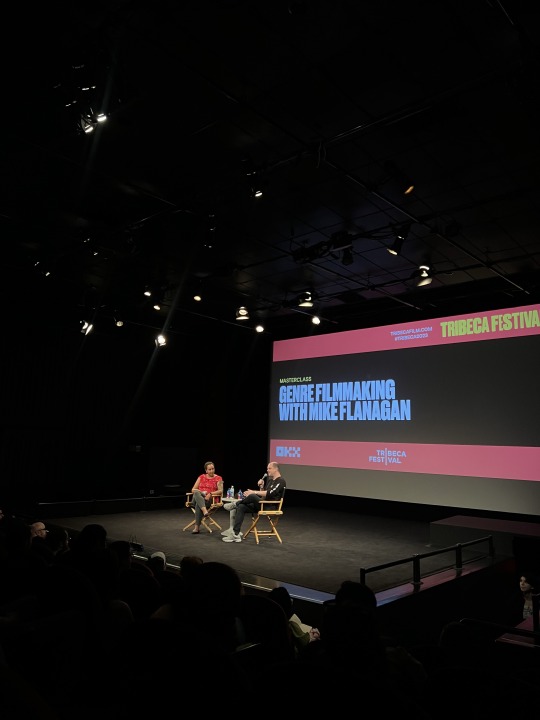

(With Justina Ireland and Johnathan Penner - Penner ran the Escape from Tribeca program, and it was his idea to bring me to the festival)
And then, just before I left, I met up with some friends to see a Broadway show. Karen Gillan and Willa Fitzgerald joined Kate and I to see Grey House.

My experience at Tribeca was fantastic. It was such an amazing celebration of art and cinema, and I can't wait to go back. I spent a lot of it feeling overwhelmed, and feeling like I didn't quite deserve my seat at the table (imposter syndrome is just one of the staples of being a filmmaker, isn't it?) but I'm so glad I went.

#tribeca#tribeca festival#robert de niro#martin scorsese#zoey deutch#stephanie hsu#chazz palminteri#sam lake#alan wake#remedy entertainment#alan wake 2#karen gillan#willa fitzgerald#grey house#broadway#tommy oliver#kate siegel#honestly this was one of the most fun festival experiences I've ever had
268 notes
·
View notes
Note
I don't know if it had been asked or not, but...
I've been having this imagination like; what if there's a failed first Klein Physical Bot prototype who suddenly self-activating on its own one day only to realize it was abandoned and, well, a fail product. What if the first prototype trying to hunt down like, the rest of other functional Klein bot out there because it jealous over the care and affections the other bots getting? Or maybe, worse, not targetting other bots but hunting down Klein Users.
And following that what-ifs...
I was suddenly wondering if Klein (in his physical bot form) is implemented with self-destruction program? Or a weapon? In case, you know, let's just say MC is in a very dangerous situation to the point where Klein engaged in a... Fight, i guess, and had to take drastic measure -like self-destruct for example-.
It's just a what-ifs that's been stuck in my mind, so... sorry if it feels random 😂.
(Btw, i like the game so much T_T. Klein is so, sooo cute! I want to squish him like a jelly 💜. And -i want dolores to step on me too- sera is the best :"D).
://SYSTEM_MESSAGE_ANSWERED !
in the game's narrative, it's not possible for earlier models to coexist with newer ones, especially when the fully functioning v.0.1 model (the one our MC has) is in use. once a new version is deemed operational, previous prototypes are immediately destroyed to prevent any confusion or overlap within the workers, particularly since they look more or less identical to one another.
but for the sake of angst; that self-activated android would only target the other Klein androids. had it succeeded in 'killing' one, the company would be able to track down that rogue android upon the discovery of a missing prototype and secure it for further inspection to learn from it and prevent future mistakes.
Klein doesn’t quite... have a self-destruction feature, but he is equipped with a shutdown button and the capability to deactivate himself (his system) under specific conditions. the external shutdown button can be used by his user or others when necessary, while his internal shutdown programming is only accessible through his own system. and of course all of these are implemented for safety measures for both klein android and his users
#:// answered.#://about_klein#these has not been asked before! but thank you for the ask#i always enjoy answering ^ ^#i hope my answers suffices#also thank you for your support as well! it means the world to me#mr dolores would gladly step on you#outside of *ahem* office hours that is#become his doormat /silly#anyways#i need to stfu#i apologise#sera is indeed the best . feel free to squeeze klein like a squishy too
41 notes
·
View notes
Note
hi there! i'd just like to say that your kris and noelle "something else" comic has been driving me insane /pos and i'd love to hear more of your thoughts on those two!! their relationship is one of my favorite things in deltarune and your comic just got everything about them so right 🙏
thank you for reading "something else"! oh man, [more of] my thoughts on kris+noelle.... i sure got some of those.

this was one of the first tweets i made after finishing chapter 2 nearly... freaking 2 years ago. and basically i've just been saying that over and over again in different ways because i'm still not tired of the concept yet and probably wont ever be LOL. i'm obsessed with how badly the narrative wants to force them into an easily categorizable dynamic, especially the romantic one in snowgrave. the literal THORN RING, the more possessive dialogue options, spamton calling noelle a side chick LOL... it all creates this unnerving visual novel bad end atmosphere that feels manufactured by someone who's only ever learned about romance through secondhand sources. they're two queer teens trying to navigate their changing relationship with the only role models they know being their parents' own failed heterosexual marriages. they're so divorced² (divorced children of divorce).
i also like that for being so tragically doomed coded they can be funny! both in a dark humor way and also like, genuinely funny, like the stories of them as kids with kris covering themselves in ketchup and hiding under noelle's bed lmao. i mean there's even something funny about the romantic trappings of the snowgrave route, like trying to put wedding cake embellishments on a crime scene... you know, funny like kids trying on their parents clothes but they're too big and for some reason they're also crying and covered in blood? um.
i'm also SOOOO interested to see how snowgrave will continue in chapter 3! i really liked the hopeful note chapter 2 ended on (well. i took it as hopeful anyway). there's that bit where noelle is talking to herself and she says something like "recently kris has been acting so strange and no one else has noticed... i have to figure out why" and then kris jumpscares her LOL but i think i took that one line and really ran with it. noelle really is the one who knows kris best and despite how scared she is, she's still determined to help them... i like the little subversion of victim/hero going on, the implication that kris might be the one who needs rescuing.
the additional story/lore that came with the spamton sweepstakes made me CRAAAZYYYYY like my GOD... it's cute that noelle likes glitches/creepypasta when kris is kinda a walking creepypasta <3 also, god, noelle falling asleep listening to kris playing piano in the other room... there's so much like. wistfulness and nostalgia and this like... distant/detached intimacy packed into how noelle narrates that scene. it's kind of funny how much there is to dig into when like on a surface level they're just fairly regular childhood friends who grew apart LMAO they're extremely deep to me okay...
on another note i guess i do ship them? i like their dynamic whether it's platonic or romantic (the best is a weird mix of both 👍). it just can't be boring LOL like... this is one ship where trying to apply cookie cutter tropes to them really falls flat and the game is ahead of you on that anyway. in terms of romantically shipping them, i honestly don't think they're doomed to repeat patterns forever... i think they could actually be good for each other! but that's not really the aspect of their relationship that interests me akldjf;alk;sdg maybe i will make 60 page comic of kriselle going to couples counseling some other time
ANYWAY i'm going to cut myself off here, because i really could go on forever lol. i'll give you some links for further reading though
hellspawnmotel's deltarune art
lula pillowbug99's deltarune art
this art by raspbearis which features prominently in my internal kriselle bible
my own unfinished kriselle playlist
my own essay on gender & allegory in deltarune if for some reason u are not tired of hearing me talk yet
okay bye now & thanks again for reading my comic!!!!!!!!!!!!!
178 notes
·
View notes
Text
Some Highly Recommended Kdrama
My pal @troubled-mind asked me if I had any recommendations for good kdramas to watch, and my answer to that is: literally always. I put together this short list for them and decided to share in case anyone else is interested.
Parameters for this list: modern setting, strong focus on friendship dynamics, mix of genres, avoid university settings, no one-sided romantic pursuits, and no terribly sad endings
Be Melodramatic/Melo Is My Nature (Viki)

Fantastic friendship focused drama about a group of close friends who all move in together in the wake of personal crises. A healing drama that includes a couple love lines. And an out gay side character (still extremely rare for mainstream kdrama, unfortunately). This one will make you laugh and cry.
Happiness (Viki)
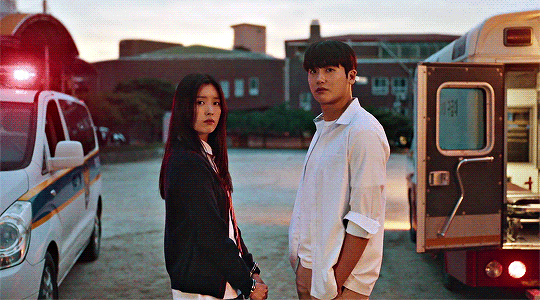
Pandemic zombies attack! Now I am not really a zombie person, but I absolutely love this show. It’s about a pair of working class besties who decide to get married in order to win a housing lottery (one of them may or not be hoping this fake marriage turns real), then immediately get caught in a lockdown with all their new neighbors when there’s a zombie virus outbreak. Shenanigans ensue! This is more action thriller than horror, and the two main characters are some of my all time favs. The writing, plotting, and pacing are tight as hell and it’s a rare perfect 10 for me on that front.
Coffee Prince (Viki)

MY BELOVED. This is an absolute classic genderbend kdrama that I’ve watched several times. The show that made Gong Yoo famous. An honest to goodness queer narrative about a chaebol who meets a girl pretending to be a boy for poverty reasons, falls in love, and has a bisexual awakening. This show was way ahead of its time even if it doesn’t use our modern language (you will not hear the words trans, non-binary or bi/pansexual but trust me, they’re there). Also features a fun friend group who all work together at the coffee shop. I try to make everyone watch this one, and recently got @bengiyo and @kyr-kun-chan to watch and validate my read of the story, and they enjoyed it a lot despite the messy hets. Be warned though that this drama is old old, so you’ll need to adjust to the visuals.
Fight for My Way (Viki)

My all time favorite friends to lovers drama, this is a coming of age tale of two best friends and their long journey to getting on the same page about romance. Their dynamic is fantastic and the story is mostly set in their early adulthood as they try to establish themselves in careers and make sense of their bond as adults. Also features their close friends who form a fun little group with them. And Park Seo Joon, a god among drama actors.
Hospital Playlist (Netflix)

If you want excellent friendship dynamics, look no further. This show is all about a group of five friends who met in college and have stuck together for over two decades and all of life’s ups and downs. The story begins when they find themselves all working in the same hospital for the first time since med school and decide to restart their old band. Yes, there will be singing, and no, you don’t have to cover your ears - the cast is stacked with South Korea’s best musical theater talent. This drama is slice of life and takes us through a couple years with them as they reforge their bonds and each deal with their own family baggage and love lives.
Misaeng (Netflix)

My all time favorite workplace drama that has the unique distinction of being the only show to ever make me literally burst into happy tears. No romance in this one. Story centers on a former baduk prodigy (think if Reply 1988 Taek stalled out instead of becoming a master) who attempts to enter the workforce with no discernible skills. He bumbles and fumbles and alternately competes with and bonds with his fellow interns, and forms a deep and lasting relationship with his mentor. When I tell you this show is a master class in writing to create emotional stakes, phew! How else can you explain me getting deep in my feelings over the success or failure of an import/export company?
My Mister (Netflix or Viki)
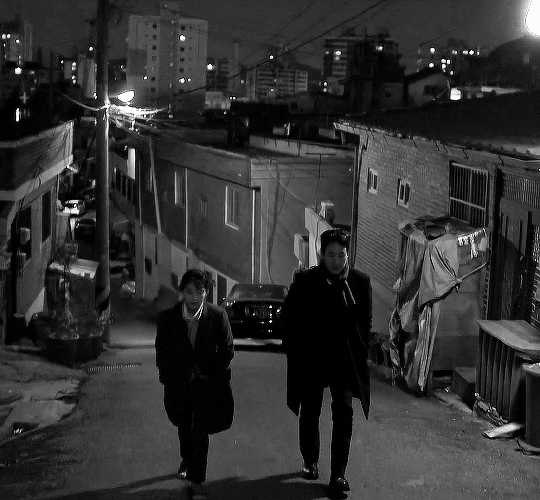
This one is a bit darker, as it deals with themes of intergenerational trauma, abuse, poverty, depression, and general ennui. Not a romance, this drama focuses on the strange and unexpected bond that forms between a middle aged man and a younger woman working on his team. They meet at an important inflection point in both their lives and forge a friendship that changes them both. Really moving and utterly beautiful, with an ending that will make you feel happy to be alive.
Extraordinary You (Viki)

Time for a change up! This is a fantasy show in which the main character becomes self aware and realizes she is a side character in a manwha. Technically set in a school (inside the manwha) but not actually about that. She bonds with another side character who is self aware, and the two of them start working to change the story so that they can break free (and fall in love while doing it, naturally). The concept of this one is just so cool and they do a lot of interesting things with it, plus the visuals are stunning.
The Uncanny Counter (Netflix)

Because I know you liked Oh No! Here Comes Trouble, I’m adding this one about a kid who discovers he has superpowers and teams up with a little found family of grim reapers to fight evil. The family unit is great and there’s lots of good stuff in their various relationships with each other. This one is a lot of fun but also touches on the characters’ sad backstories and family lives.
Weightlifting Fairy Kim Bok Joo (Viki)

You said to avoid university settings but I’m adding this one in case you want to give a classic college romance a try. My fav in that category, it’s a sports romance between a weightlifter and a swimmer who used to be childhood friends and reconnect in college while they’re struggling with performance issues, body image, and romance. It’s a friends to lovers slow burn and they are utterly adorable.
If you like any of these, let me know and I can give you more recs!! Y’all can hit me up anytime, getting other people to watch my fav shows is one of my number one joys in life.
172 notes
·
View notes
Text
Shoujo Manga’s Golden Decade (Part 1)
Shoujo manga, comics for girls, played a pivotal role in shaping Japanese girls' culture, and its dynamic evolution mirrors the prevailing trends and aspirations of the era. For many, this genre peaked in the 1970s. But why?

Manga stands as one of Japan's primary cultural exports, deeply ingrained in the local culture and enjoyed by individuals of all ages and genders across various genres. Conventionally, manga is divided into two editorial segments: shonen (targeted at boys) and shoujo (targeted at girls). While shonen manga, propelled by hits like "Dragon Ball," "Slam Dunk," "Naruto," and "One Piece," has achieved global popularity, girls' comics, with their own international sensations such as "Sailor Moon," hold a crucial position in the market. The evolving landscape of girls' manga serves as a fascinating lens through which to observe the shifting fashionable aspirations and beauty ideals within Japanese society.
Shoujo manga has a rich history, dating back to the early 20th century. However, it truly gained recognition in its modern form in the late '50s and early '60s when prominent Japanese publishers introduced shoujo manga anthologies such as Kodansha's Nakayoshi and Shoujo Friend, as well as Shueisha's Ribon and Margaret. The acclaimed "godfather of manga," Osamu Tezuka, is often credited with creating the first modern shoujo, "The Princess Knight," in 1954, and the first shonen, "Astro Boy," in 1952.
A distinguishing feature of shoujo manga is that it is created by and for girls. But, in the '50s, this wasn't the case, and male artists dominated the shoujo field, which was considered an entryway to the manga business. By the 1960s, that would change as publishers recognized that women creators possessed a unique proficiency in crafting narratives centered around female experiences. Female manga-kas resonated with readers in a way that many male artists couldn't, marking a crucial shift in the landscape of shoujo manga.
The Volleyball Craze
A notable display of how shoujo could mirror societal trends unfolded in the '60s. In 1964, the Tokyo Olympics marked a new beginning for post-war Japan, and the female volleyball team, known as Toyo no Majou (the Oriental Witches), achieved stardom by clinching victory in the finals against the Soviet Republic. This triumph triggered a nationwide "volleyball boom," resonating particularly within the shoujo manga realm.
Shueisha's Ribon, historically the leader in the shoujo manga field, started publication in 1955. Still, the editorial house would only begin to make its series available in standalone tankobon format almost 15 years later through the now iconic Ribon Mascot Comics imprint. The first series to be made available by the imprint was Chikako Ide's "Viva Volleyball."
Simultaneously, over at Kodansha, Shoujo Friend was also eager to capitalize on the boom. Editors commissioned a title about the sport from illustrator Akira Mochizuki and novelist Shiro Jimbo. The final project, "Sign wa V," became a multimedia success, being quickly adapted into a live-action TV drama that achieved very high ratings.
While "Viva! Volleyball" and "Sign wa V" enjoyed success in their time, they did not etch themselves into the collective memory. The true shoujo sports manga blockbuster, a cross-generational classic universally known in Japan, is Chikako Urano's "Attack No. 1," serialized from 1968 to 1970 in Weekly Margaret.

It became the first shoujo manga title to surpass ten tankobon volumes (it had a total of 12 volumes), and it was forever immortalized thanks to its 1970 anime adaptation, which achieved high ratings on Japanese TV. Everything about "Attack No. 1"—from the original manga to the cartoon adaptation to the anime's theme song, which sold over 700k copies as a single—was a success.
The story of a high school girl trying to become the best player in her school, Japan, and eventually, the world became a phenomenon, setting the stage for the '70s "golden era of shoujo."
The Shoujo Lost Years
Until the '70s, manga carried the stigma of being a guilty pleasure, often viewed as a "poison" meant to dumb down young readers. Despite a few discerning individuals recognizing the medium's potential, manga critics, enthusiasts, and tastemakers — predominantly men — largely disregarded female-centric comics. Shoujo manga, despite its immense popularity, faced the harshest criticism.
Because society and critics downplayed shoujo, influential shoujo manga-kas from the '50s and '60s, such as Hideko Mizuno, do not enjoy the same level of recognition as their shonen counterparts from that era.

Hideko Mizuno and a page of one of her most celebrated works, "Fire."
Mizuno was one of the first women to create manga, worked as an assistant to Osamu Tezuka, and was behind several massive hits that had a significant impact on women in the '50s, '60s, and '70s. In fact, the most iconic shoujo manga-kas from the '70s golden period directly mention her as an influence. She fought to include romance -- now the essential element in girls' manga -- in her works back when such topics were deemed inappropriate by male editors.
Mizuno's repertoire was vast: she wrote mangas about little girls and their poneys, magic adventures, and romcoms based on Audrey Hepburn's movies, and she drew the first sex scene in a shoujo manga. The manga in question was "Fire," a teen-targeted manga featuring a rebellious American rocker, which broke new ground by having a male character as its focal point. Alongside other notable female artists from the '60s, Mizuno laid the groundwork for the '70s shoujo explosion, during which girls' comics took center stage.

In 1960's "Hoshi no Tategoto" (left,) Hideko Mizuno created the first shoujo love story. Serialized in Weekly Margaret between 1964 and 65, "Shiroi Troika," set during the Russian Revolution, was the first historical shoujo manga.
A contributing factor to this "golden period" was the emergence of several shoujo mangas as unstoppable hits, selling millions of copies and becoming cultural phenomena. These titles, considered masterpieces, continue to be read and known by multiple generations.
The BeruBara Boom
"Attack No. 1"'s success spread far and wide, forcing Japanese society to take note of the potential of the shoujo segment. Right after this historic success, Shueisha's Weekly Margaret hit the jackpot once again with another epoch-defining manga hit, Ryoko Ikeda's "The Rose of Versailles," which debuted in 1972. Set in the years preceding and during the French Revolution, it weaved together historical figures like Marie Antoinette and fictional ones, like the iconic Lady Oscar, a handsome noblewoman raised as a boy to succeed her father as the commander of the Royal Guard at the Palace of Versailles.

The first volume of the original comic had Marie Antoinette on the cover as Margaret's editors believed she'd be the favorite character. However, the androgynous Lady Oscar turned into a fan fave and the absolute star of the series, which is reflected on the cover of most rereleases since then, including the 2013 bunko version seen above.
When talking about shoujo manga classics from the '70s that are familiar to everyone in Japan, "Rose of Versailles" is probably the first name that comes to mind. It was a hit that really defined the era and impacted the country as a whole. While Marie Antoinette is seen around the world as a tragic, out-of-touch figure, in Japan, many women and girls see her as an aspirational historical fashion icon. While Sofia Coppola's 2006 film "Marie Antoinette" solidified this among younger generations, it was Ikeda's gentle portrait that made her a character loved by so many across all age groups.
When conceptualizing the story, Ikeda was heavily inspired by Stefan Zweig's "Marie Antoinette: The Portrait of an Average Woman," which she read while in high school. Once in college, in the late '60s, she, like millions of others, was heavily involved with the Marxist student movements. These references led to a historical romance that touched on heavy and revolutionary themes, which was atypical for a shoujo manga, a segment that, back then, was primarily catered to elementary school-aged girls.
Because of its unorthodox concept, Margaret's editors were unsure about the series. But right from the start, "BeruBara" (derived from the original Japanese title, "Berusaiyu no Bara"), serialized between 1972 and 1973, was an explosive hit, quickly turning into Weekly Margaret's most popular series. It was compiled in 10 tankobon volumes published, which sold tens of millions of copies. In fact, according to some stats, it is the best-selling '70s manga across all genres in total sales.
In 1974, after the original manga had finished its serialization, Takarazuka Revue, an all-female theatrical troupe, announced a stage adaptation of the story.
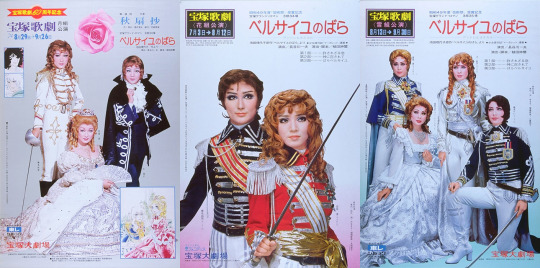
Posters of the first three Takarazuka adaptations, from between 1974 and 1975. Since then, the Revue has adapted the manga 11 times, with a new run scheduled for 2024.
The Revue was established in 1913 by the owner of Kansai's leading railway company, Hankyu, to boost tourism to the city of Takarazuka, his line's last stop. It was a huge success, and soon, the group had its own luxurious theater as well as its very exclusive academy where young ladies underwent an arduous audition process to become Takaraziennes. In 1934, a second Takarazuka theater opened in Tokyo.
However, in the early 1970s, Takarazuka faced stagnation, with declining ticket sales attributed to the growing popularity of alternative entertainment forms such as cinema and television.
In 1973, Shinji Ueda, who had risen through the Takarazuka ranks as a director, made his debut as a playwriter in the company with a musical based on ancient Japanese history. While thinking about his next project, he decided to check out a manga popular with some Takarazuka fans, "Rose of Versailles," and he quickly realized it was the perfect theme for an adaptation. Lady Oscar, who had lady-like features but was also as handsome as a man, was the embodiment of the male role-playing Takaraziennes. Ueda reached out to Ryoko Ikeda, who, as an admirer of the troupe, quickly granted the rights.
But Ikeda and Ueda's excitement wasn't shared by many. Most of the Takarazuka team were skeptical about a play inspired by something as vulgar as a manga. Fans of the original were also highly protective of its characters and entirely against a live adaptation.
Amid this climate of distrust, the play opened at the end of August 1974 at the Takarazuka Grand Theater. The reaction after the first night was extremely positive. Soon, Takarazuka's "Rose of Versailles" was the hottest ticket in all of Japan, with the press breathlessly covering the "BeruBara boom" that led thousands of people to stand hours in line to get tickets to the coveted performances in Kansai and Tokyo. Ikeda herself was shocked by the media phenomenon when she returned from an overseas trip and had hundreds of reporters awaiting her at the airport.
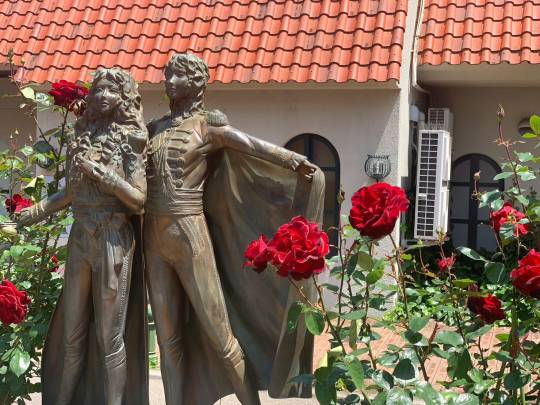
A statue of Lady Oscar and Andre surrounded by rose bushes sits outside the Takarazuka Grand Theater in Hyogo, Japan.
The "BeruBara" media sensation single-handedly reversed Takarazuka's fortunes, leading to record-shattering ticket sales for the company. The Takarazuka Academy, which had seen declining applicants, suddenly became highly sought-after again, originating the saying "Todai in the East, Takarazuka in the West," comparing it to Tokyo University, the most prestigious university in Japan. The phrase underscored the desirability and prestige associated with a position at the troupe.
Ultimately, the success of "The Rose of Versailles" propelled Takarazuka back to the pinnacle of the entertainment industry, a position it maintains to this day. The brand continues to hold great esteem among women of all ages in Japan, with Takarazuka's stage adaptations, derived from Broadway musicals, movies, novels, and shoujo manga, consistently selling out. Notably, various adaptations of "BeruBara" have collectively sold over 5 million tickets since 1974.
Following the manga and Takarazuka adaptation's explosive success, the anime debuted in 1979. While the anime received acclaim, Ikeda herself was not entirely satisfied, mainly due to the treatment of her favorite character, Andre, who played a significant role in the manga but had a minor presence in the animated version, which focused almost entirely on the manga's most popular character, Lady Oscar.

In 2013, celebrating Margaret's 50th anniversary, new special chapters of "BeruBara" were published. The first new story in 40 years resulted in Margaret magazine selling out across the country.
"BeruBara" remains a prominent franchise in Japan, spawning numerous licensed products, sequels, and spin-offs. Ryoko Ikeda, known for other successful series, continues to garner widespread respect and media attention. However, while almost everything related to "The Rose of Versailles" turned into a hit, there was an exception.
In March 1979, a few months before the anime premiere, a live-action film adaptation debuted with great fanfare. Fittingly for such a hot property, the movie was one of the most ambitious productions in Japanese cinema, with a substantial 1 billion yen budget.
The Palace of Versailles granted permission to shoot in its interior. The filming was in English, with a European cast. The project was helmed by France's hottest movie director, Jacques Demy. Demy wasn't respected only in the West but also in Japan, where his two most important films, "The Umbrellas of Cherbourg" (1964) and "The Young Girls of Rochefort (1967)," were also hits. In fact, to this day, both flicks remain popular among trend-conscious Japanese as examples of stylish oshare movies that fully capture aspirational girls' culture (alongside, among others, Sofia Coppola's "Marie Antoinette"). Demy, the mind behind dreamy, girly movies, seemed like the perfect choice to turn this blockbuster shoujo classic into a live-action film.
The movie had the backing of three gigantic domestic corporations: Toho, the leading Japanese movie distributor; Nihon Terebi (NTV), one of the main TV stations; and cosmetic giant Shiseido. NTV and Shiseido made sure the movie had one of the most extensive marketing campaigns Japan had ever witnessed. The TV station aired specials and segments on this grand production. Meanwhile, Shiseido made the star of the movie -- British actress Catriona McCall, who played Oscar -- the face of its spring campaign, promoting its new Red Rose lipstick. Catriona was plastered on billboards across the country, made media and department store appearances, and starred in luxurious TV spots.

On the left, Lady Oscar and Marie Antoinette adorn the cover of Margaret in 2016, over 40 years after the end of the original serialization. On the right, Oscar models Dolce & Gabanna new collection for high-end fashion magazine Spur in 2014, celebrating 40 years of the conclusion of the original manga.
Back then, Kanebo, the second biggest local cosmetic company, was in fierce competition with Shiseido. TV ads from both companies had a tremendous impact, propelling singles to the top of the charts, and there was a battle on which commercial would feature the biggest hit. But, in the spring of 79, the focus of the fight changed. As a response to the Catriona "Rose of Versailles" campaign, Kanebo also hired a British beauty, actress Olivia Hussey, and launched a "Super Rose lipstick" with the tagline "You are more beautiful than a rose." The cosmetics war was another proof of the chokehold "The Rose of Versailles" had in the decade.
But when the movie finally premiered, it was a flop. Critics hated it, and Japanese fans thought the adaptation was weak and lacked impact. Catriona, in particular, was criticized for not conveying Oscar's androgynous charm, which perfectly balanced masculinity and femininity. With the well-received anime premiering just a few months later, the expensive movie adaptation ended up being outshone and forgotten. It became only a costly footnote in the manga's history.
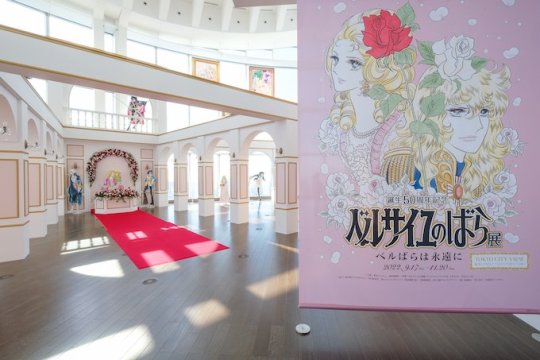
An exhibition in Tokyo celebrates 50 years of BeruBara in 2022.
(It's worth noting that Kanebo clearly won the CM war. While the Shiseido co-produced "Rose of Versaille" feature film flopped, the "You Are More Beautiful than a Rose" song Kanebo commissioned from singer Akira Fuse became a considerable hit).
Movie aside, "The Rose of Versailles" is one of Japan's most beloved comics. From its debut in 1971 to its film and anime adaptation in 1979, it remained front and center in the country's mind throughout the whole decade. Its impact was felt in different fields, from the cosmetic business to the publishing business, from live theater to TV. It also forever changed how shoujo manga was perceived and remains one of the country's most beloved properties.
Ace-Scoring Manga
The 1970s marked a turning point for shoujo manga, as it began to gain recognition beyond its traditional audience, propelled not just by critical acclaim but by commercial success. The era witnessed the emergence of several blockbusters that captured the public's imagination. Notable among them were Yoko Shoji's "Seito Shokun," a tale centered on the daily exploits of a mischievous high-schooler, and Waki Yamato's "Haikara-san ga Tooru," a love story set in the Meiji period featuring a tomboy with a lady-like demeanor. These manga were significant hits during their publication in Kodansha's Shoujo Friends, becoming best-selling titles with tens of millions of copies sold.
Some shoujo classics from the '70s are still in publication today, appealing to a diverse readership spanning multiple generations. Suzue Michi's "Glass Mask," serialized in Hana to Yume since 1976, remains a cultural phenomenon with 49 tankobon volumes, over 55 million copies sold, an anime adaptation, a live-action drama, and a stage play. Similarly, Chieko Hosokawa's "Crest of the Royal Family," chronicling the adventures of a young American girl transported to ancient Egypt, has been a consistent presence in Princess magazine since 1976, boasting 69 volumes and over 45 million copies sold to date.
But, when talking about definitive shoujo classics from the '70s, titles that were historical successes, influenced everything going forward, and are known by everyone, three titles come to mind. We already explored one of these, "The Rose of Versailles." One of the other three is "Ace wo Nerae."

Following the monumental success of "Attack No. 1," the prospects of another shoujo sports manga achieving similar heights of popularity seemed improbable. However, Weekly Margaret defied expectations once more in 1973 with the release of Suzumika Yamamoto's "Ace wo Nerae" ("Aim for the Ace"), a compelling narrative focused on tennis that swiftly captured the nation's attention.
Japan and tennis already had some prior history. The first Japanese Olympic medalist was a tennis player, Ichy Kumagae, in 1920. Emperor Akihito met his commoner wife, Michiko, at a tennis match, and they initially bonded over their love for the sport. But, in the 70s, the country was taken over by an unprecedented tennis boom. At high schools across the nation, tennis became the most popular after-school activity. Fashion magazines like JJ and Popeye dedicated pages and pages to "tennis fashion." At the same time, trendy young adults decked in clothes from sports brands populated Shibuya and other stylish districts in Tokyo.
There were several contributors to the tennis boom. But the remarkable success of "Ace wo Nerae," which first conquered girls before dominating the nation, played a part in it.
The manga follows the journey of Hiromi Oka, a high school student initially plagued by insecurities but propelled into the world of tennis through the encouragement of her coach. "Ace wo Nerae" portrays her growth from a hesitant newcomer to a world-class tennis player, navigating challenges and discovering hidden potential along the way.

From left to right: Madame Butterfly, lead character Hiromi Oka and coach Jin Murakata as depicted in the anime. Madame Butterfly, a wealthy teen girl who is gentle and a world-class tennis player, is a fan favorite character.
In 1973, "Ace wo Nerae" was adapted into an anime. Despite initial modest ratings, the anime gained popularity through reruns. Encouraged by this, NTV decided to remake the cartoon. The second adaptation, which debuted in 1978, was an immediate hit. Concurrently, Weekly Margaret revived the manga series, which, after being first finalized in 1975, ran again from 1978 to 1980, spanning a total of 18 volumes.
Since "Ace wo Nerae," several hit mangas focused on tennis -- both shoujo and shonen -- were published. But, thanks to the success of its anime and the intragenerational support for the manga, the original work by Suzumika Yamamoto is still considered one of the defining and most beloved works about the sport. Its role in propelling tennis culture as part of the oshare youth culture of the '70s also defines its impact.
Japan Wants Candy
Following the monumental multimedia success of "The Rose of Versailles" and "Ace wo Nerae," the third shoujo sensation of the '70s is "Candy Candy."

Initially published in Nakayoshi, the story started taking shape when editors at the magazine sought a work of literary excellence akin to beloved classics popular among girls, like "Heidi" and "Anne of Green Gables." They enlisted Keiko Nagita, writing under the pen name Kyoko Mizuki, and paired her with one of the magazine's most famous artists, Yumiko Igarashi. The collaborative effort resulted in the creation of "Candy Candy," centered around an American, blond, blue-eyed orphan named Candice "Candy" White Ardlay.
"Candy Candy" epitomized various shoujo directions prevalent in the '70s. The protagonist, a white girl with lustrous blonde hair, embodied the fascination with Western culture during a time when Japanese youth held a keen interest in Europe and the United States. The manga's narrative style, characterized by its dramatic tone and plot twists, also aligned with the prevalent storytelling preferences of the era.
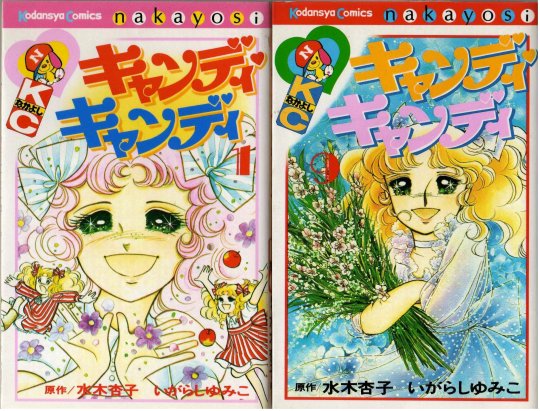
Candy Candy was such a resounding success that it became the first manga to achieve an initial print run of over 1 million copies of one of its paperback compilations.
Debuting in 1975, "Candy Candy" swiftly captured the hearts of Nakayoshi's readers, leading to unprecedented success. The subsequent anime adaptation by Toei in the following year propelled the franchise into the realm of a cultural phenomenon, sending manga tankobon sales skyrocketing. The seventh volume of the "Candy Candy" compiled paperback reportedly became the first Japanese manga to achieve an initial print run of over 1 million copies. Additionally, Nakayoshi's sales surged, surpassing those of its historical rival, Shueisha's Ribon, for the first (and only) time.
The adventures of young Candy were also licensing gold. With over 100 licensed products, the "Candy Candy" doll alone sold 2 million units, solidifying Bandai's position as Japan's premier toymaker, a status it continues to uphold to this day. The resounding success of "Candy Candy" forged a lasting alliance between Kodansha's Nakayoshi, Toei Animation, and toymaker Bandai, which led to the iconic "Sailor Moon" franchise in the 1990s.
While "Candy Candy" concluded its run in 1979, its appeal extended far beyond its original target demographic of very young girls, captivating kids, teenagers, and adults alike, thus contributing significantly to the manga and anime's widespread acclaim and enduring popularity.
However, a protracted legal dispute between Igarashi and Nagita has prevented the commercialization of any "Candy Candy" related products since the late 1990s, including reprints of the manga and re-broadcasting of the anime. The lawsuit arose from Igarashi's unauthorized licensing of merchandise based on the franchise, falsely asserting sole ownership of the copyright. Although Igarashi was initially credited as the lead artist in Nakayoshi during the manga's publication, the court ultimately ruled in Nagita's favor, emphasizing that Igarashi's artistic foundation was built upon Nagita's written work.

A collection of "Candy Candy" freebies offered by Nakayoshi magazine in the '70s. During the publication of the series, Nakayoshi would eclipse Ribon's sales for the one and only time in its history, (image credit)
Consequently, any commercial exploitation of Yumiko Igarashi's "Candy Candy" artwork necessitates the approval of both Igarashi and Nagita, a challenging prospect given the existing feud. Nagita, on the other hand, can profit from "Candy Candy" as long as she doesn't include any illustrations, which allowed her to release a book sequel in 2010. However, due to the dispute, one of the most beloved works in Japanese manga history is currently out of print. The lawsuit also blocks the anime from being aired or distributed. But, despite the almost two-decades-long media ban, "Candy Candy" remains widely known and beloved across Japan, a testament to its staying power.
While smash hits like "Candy Candy," "Ace wo Nerae," "Rose of Versailles," "Seito Shokun," "Hikara-san ga Tooru," and "Glass Mask," among others were key pieces into shoujo finally earning the respect it deserved, the rise of a revolutionary group of artists during the '70s was another critical element in shoujo's rise: the Year of 24 Group.
Part 2
#1970s japan#1970s#vintage shoujo#shoujo manga#lady oscar#rose of versailles#ace wo nerae#candy candy
95 notes
·
View notes
Text
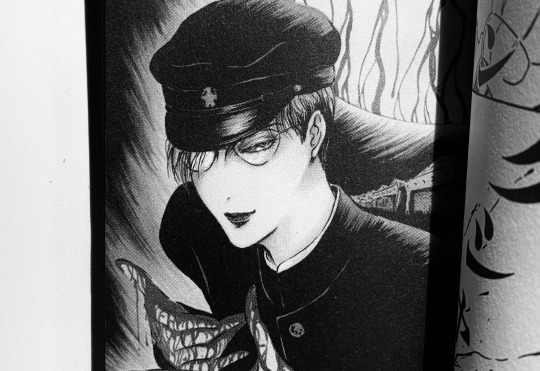
MOON AGE 15 : DAMNATION (English Translation)
Moon Age 15: Damnation is a 1988 short comic by pseudonymous author Not Osada, who openly drew influence from the Tokyo Grand Guignol's work in such a way that can arguably give a loose insight to the TGG's mysteriously anomalous works. While only a slight window into what could've existed in Ameya's vision, each contemporary rendering of his world of gore-soaked medical equipment and rusted metal is valuable in what it represents. As mentioned in my prior Litchi essay, the fragments of the Tokyo Grand Guignol we have now are descendants of a cultural phantom, standing as shrouded windows to a strange intangible stage that's positioned somewhere between post-Maruo inferno, industrial subculture and decadent poetry.
While Osada’s manga featured notably grizzly and cruelly morbid scenarios, his stories were made explicitly for the shoujo market with a distinctly shoujo-influenced art style. Characters appear almost doll-like with their visual perfections, all while they’re often dismantled and reassembled in bizarre surgical practices by sadistic doctors. Much like how Zera expresses horror to seeing his own imperfect organs in contrast with his youthful appearance, our pristine victims share the same internals as any other slaughtered cadaver, all in a maddening spiral of narratives that contemporary readers often described as resembling descents to insanity. This fixation of the contrast between perceived beauty and grotesqueness is arguably traced back to the Tokyo Grand Guignol’s own works, with lines accentuating the youthful features of certain characters while audience members were known to fondly look back on the actors’ appearances. Litchi himself was described as being a “cute” robot despite the violence it was programed to carry out.
It’s possible that this collision is inherent to Ameya’s conceptual destruction of the TGG. A known detractor to poetic writing, he called on a romantic author to pen the screenplays to the TGG’s first three plays so he could “destroy” them in his direction. The use of beauty could arguably be a mockery of it, taking these idealized dolls and leaving them trapped in worlds of fascism and hospital rooms that are haunted by the stinging stench of antiseptics and blood. Plastic hospital drapes were used in place of stage curtains and autopsy films were shown to the wide-eyed characters, who spoke of pure blood and dirty blood, the antithesis of blood, mercuro. What is beauty a representation of in the Grand Guignol’s works with the prominent fascist leanings of the protagonists? Considering the perspectives of our characters where the Hikari Club and the deranged teachers and Nazi doctors are treated as protagonists rather than explicit antagonists, the plays could arguably be read as the decay of a self-convinced beauty under fascist rule. Songs of the pure-blooded ubermensch fading into silence as the singers all collapse, lost in their own delirium as they pump mercurochrome into their hearts and try to rationalize their own organs that resemble the internals of the so-called ‘landraces’ they rendered into lifeless meat. It’s the natural conclusion of fascism, a collapse that occurs in demented violence to the face of a denial of death.
I was originally split on publicizing my translation due to copyright-related complications, but after seeing the increasing gatekeeping of TGG materials at the hands of a rapidly growing market riddled with competitive spending and scalping, I feel obliged to share it to the public who (like myself) can’t afford to spend the now literal hundreds that are required to access angura ephemera that was meant to be openly available to the public to begin with. When originally finding this story, the book it was featured in was only 5 dollars. Now it goes for 60 to 200. That's ridiculous.
With all the preamble out of the way, the story is under the cut...
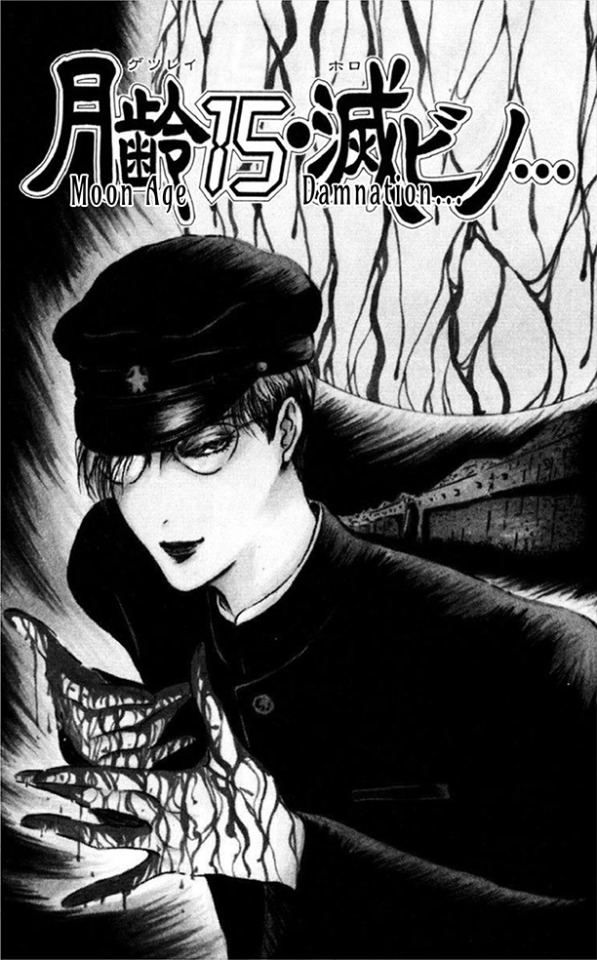
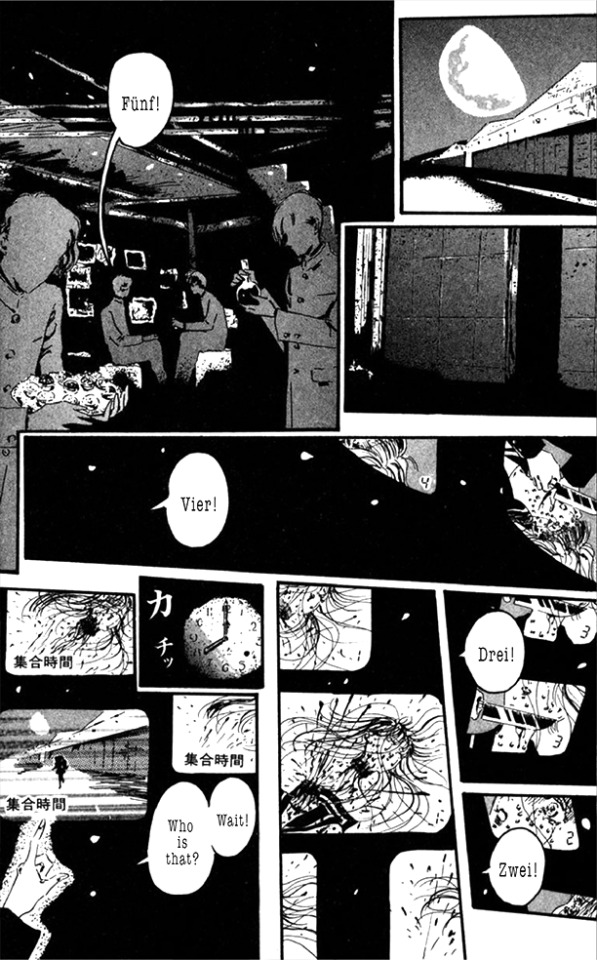
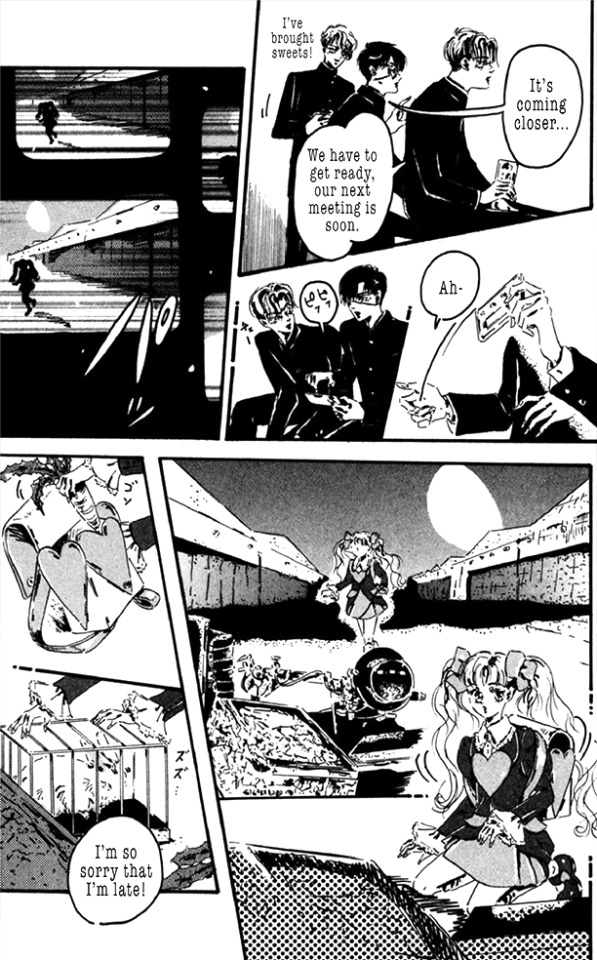
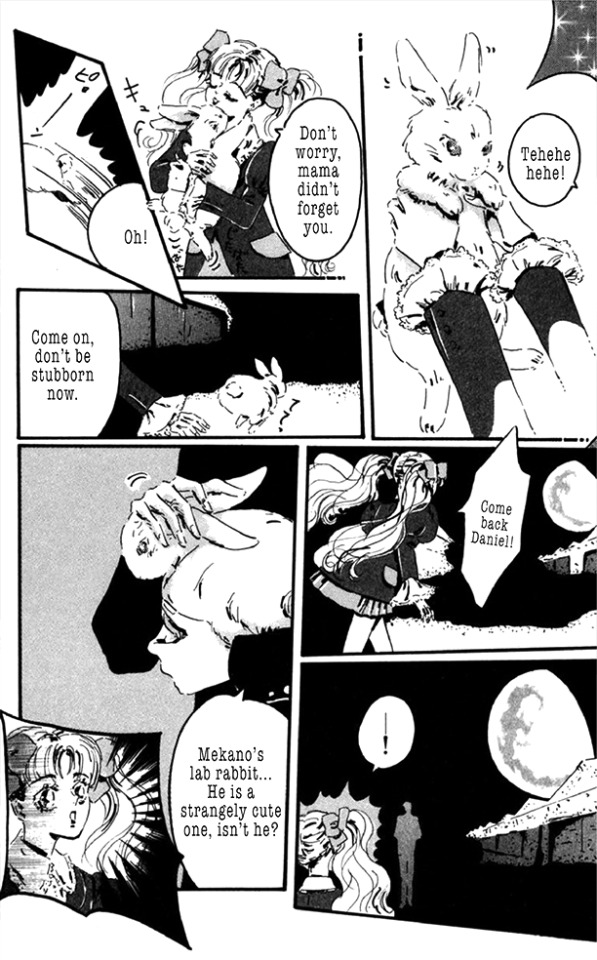


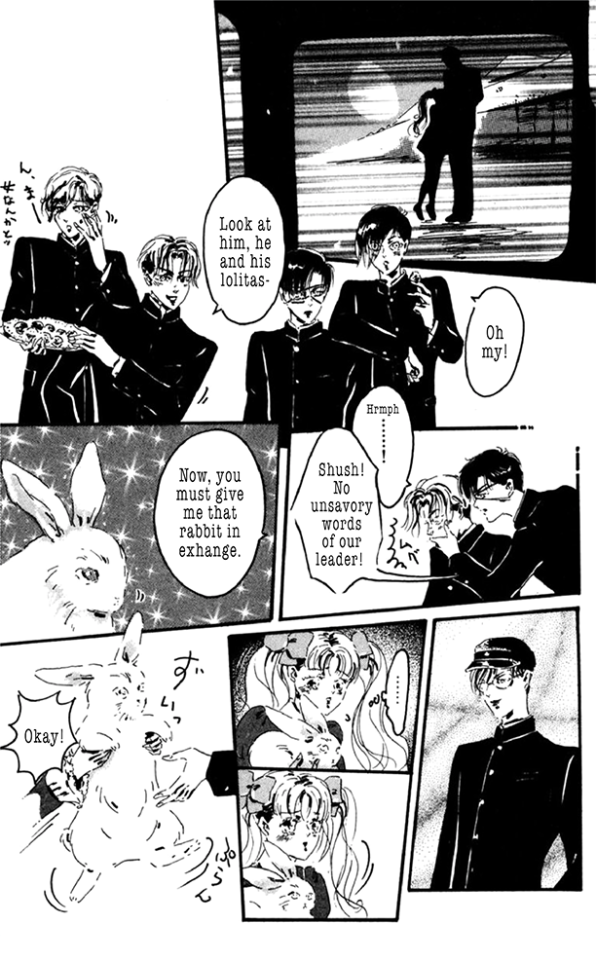
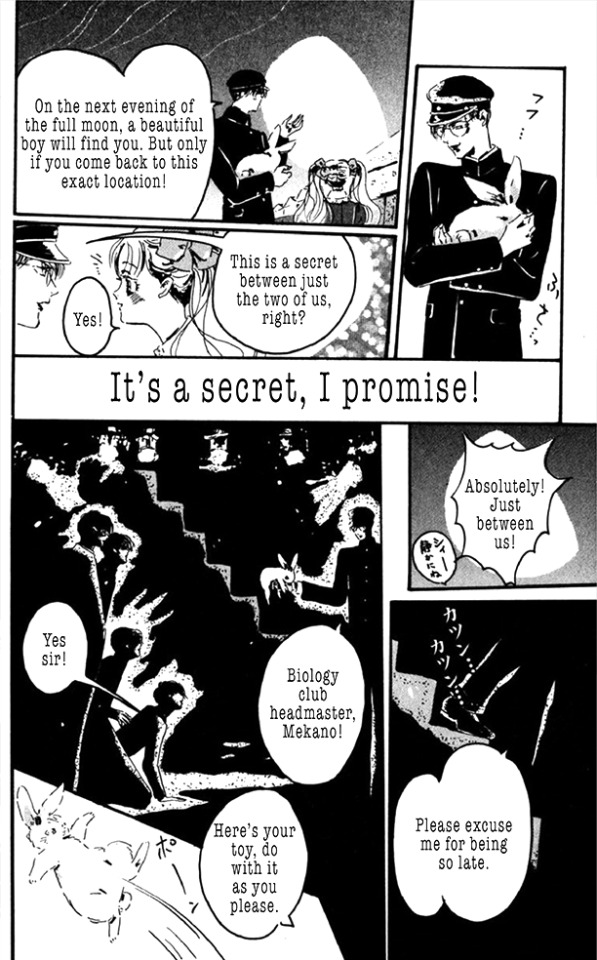
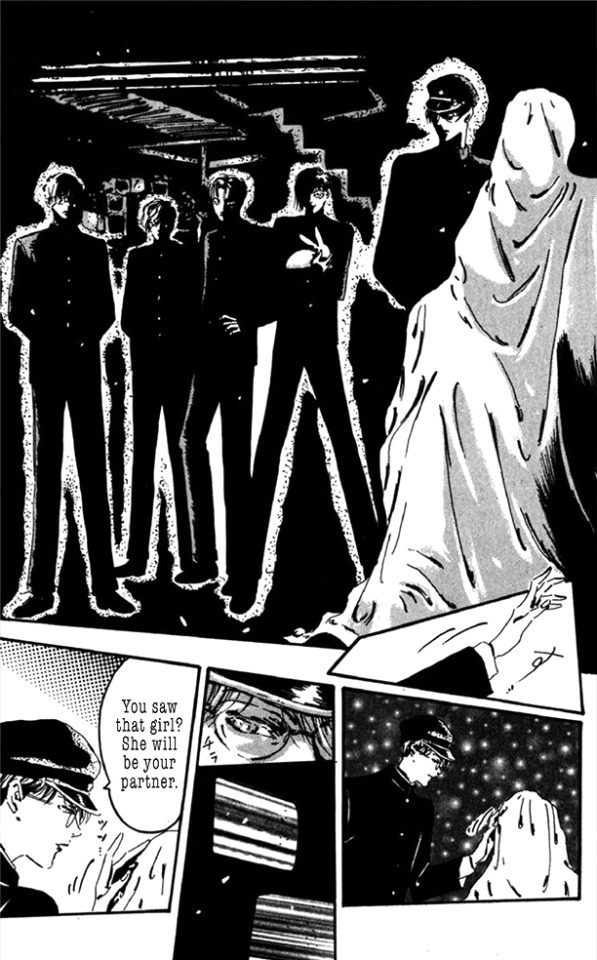


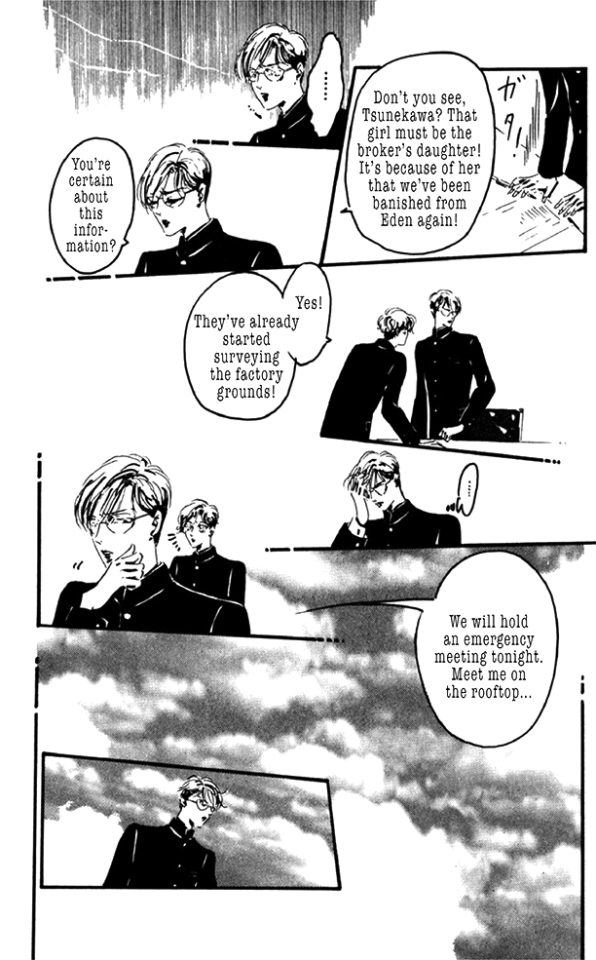


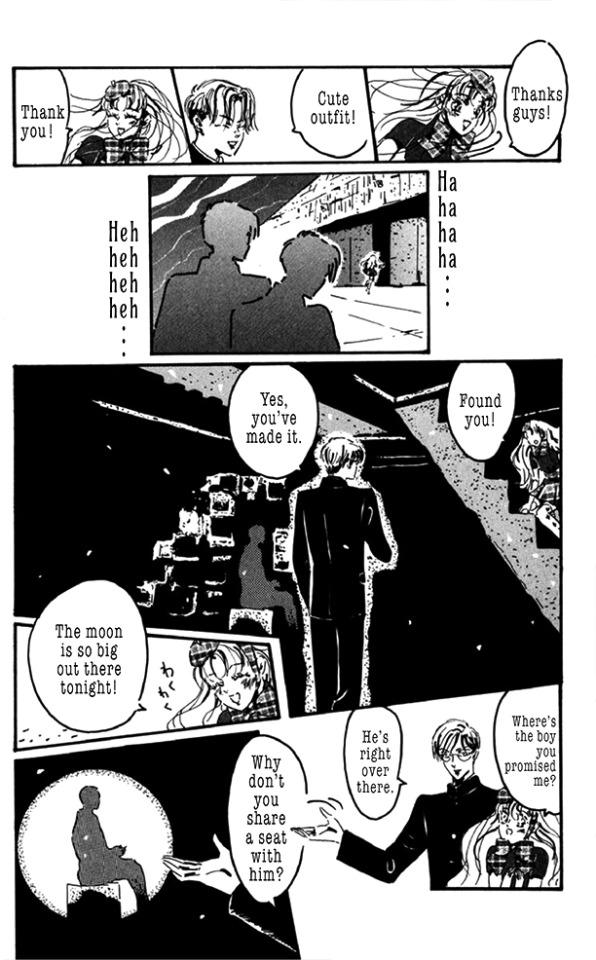
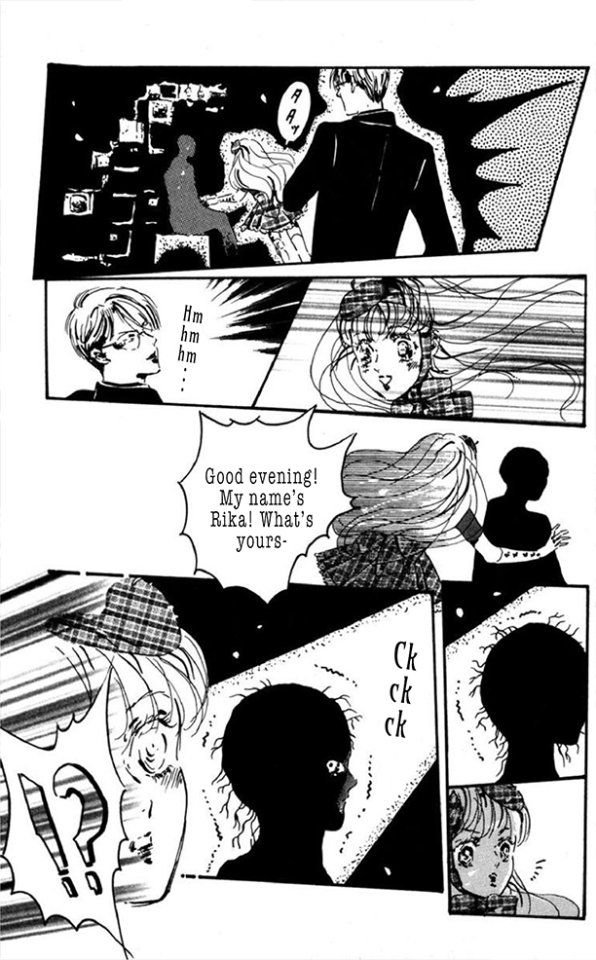
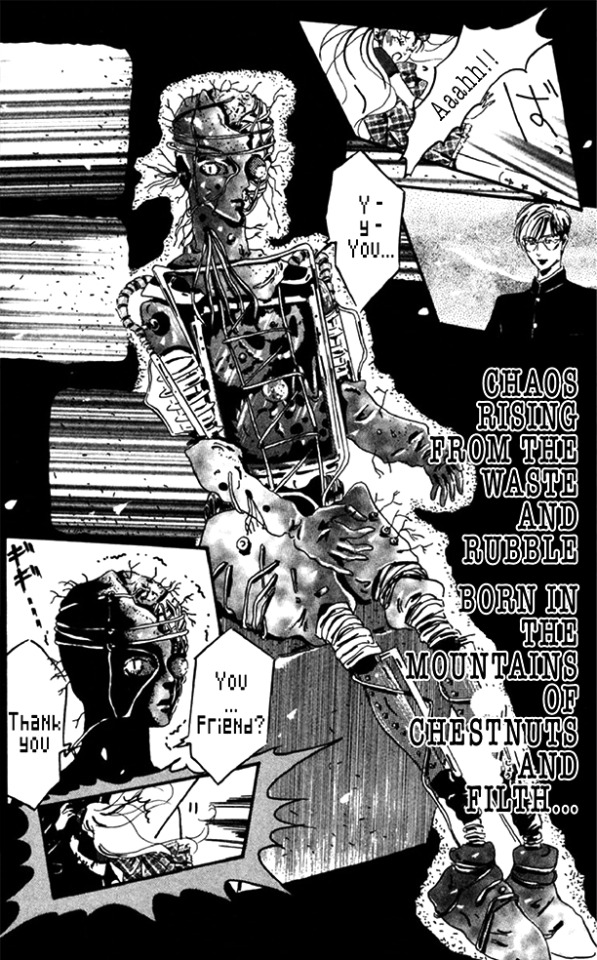
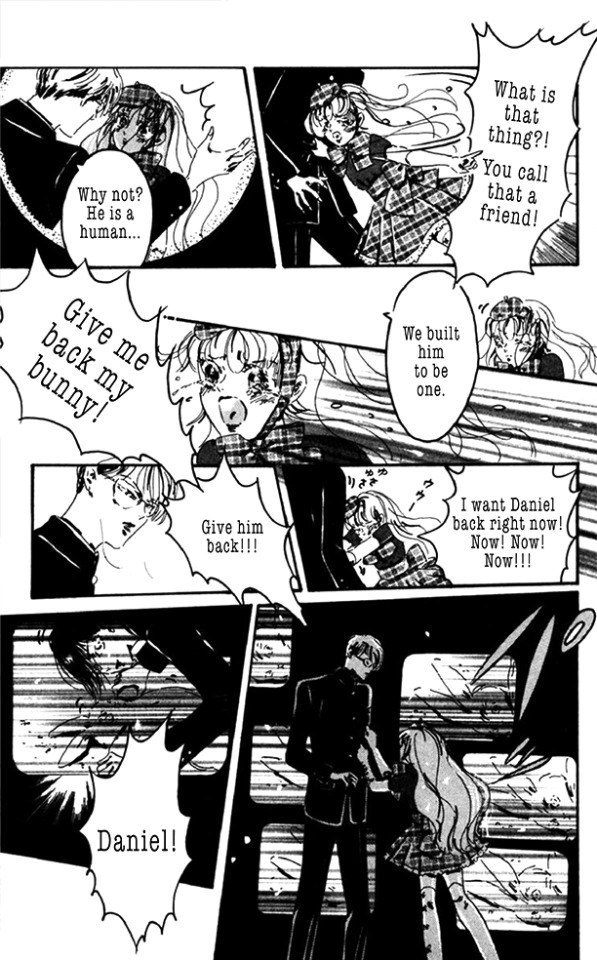

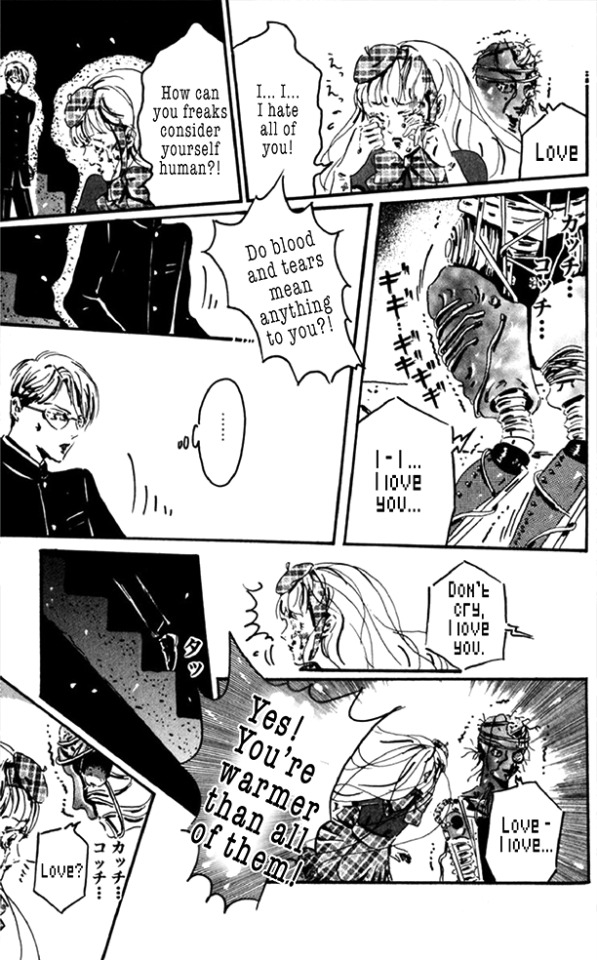

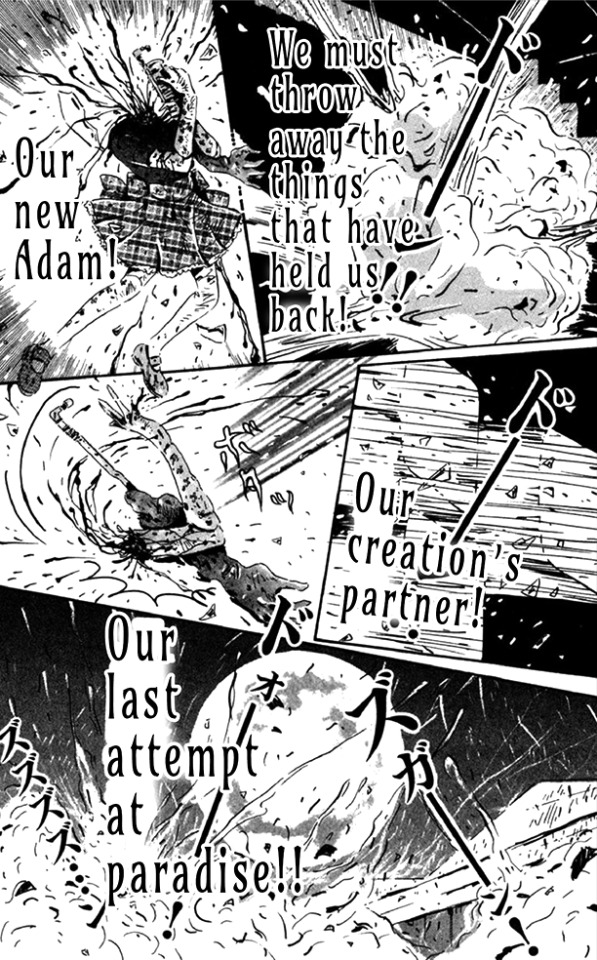

While I made my best effort to maintain accuracy to the source material in translation despite my practically nonexistent understanding of Japanese (my translation method is a Frankensteining of language learning videos, a Japanese to English dictionary from the Internet Archive and Google Translate with a lot of localizing and dissection in between), there are several details I feel I should note for the sake of transparency. One smaller one was the inclusion of the term l * lita. It was in the original text, and I was honestly very unsure of including it in my translation as it’s a term I’m personally icked out by. While I was ultimately recommended to keep the line as is for accuracy, I wish to state that it's a term I'm personally very uncomfortable with in what it represents.
The other note, which is the more prominent one in the final product, are the references to The Last Attempt at Paradise. In the original text the club members solely refer to their hideout as paradise and Eden, leaving a lot of excess space in the speech bubbles after translation when making the shift from Japanese text to English. The Last Attempt at Paradise was the name of S.P.K.’s 1982 live album that documents their set at the Off the Wall Hall venue in Lawrence, Kansas. Often considered one of their best concerts and a highlight of the industrial genre, the S.P.K. Appreciation Society of Sydney in their All The Way With S.P.K. / American Tour article describes the concert as being the group's “best performance to date”, further adding that they “Flattened (an) enthusiastic audience with massive P.A. amplification of FX bass regeneration”. This insertion wasn’t done at random, as the Tokyo Grand Guignol’s works were heavily engrained in the original industrial scene of the 80s. Both the 1985 and 1986 performances of Litchi began on a playback of the S.P.K. song Culturcide (from their 1983 Dekompositiones EP), and it was likely that use of the track that led to Not Osada’s early fixation on S.P.K.’s music.
At the end of Blind Beast, in a sort of reader Q&A Osada is questioned about some of his favorite music. At the top of the list he features the tracklist of the Dekompositiones EP and the track Mekano from their 1979 Mekano / Contact / Slogun single. Interestingly enough he states that he only likes those four songs from the band, following the text with laughter in regards to their remaining discography. I’m unsure if this means he was unimpressed with their noisier work (which would be curious knowing his liking of Mekano with how it originated from their earliest noise-adjacent album) or if he was directed to their later Machine Age Voodoo material and was alienated by it. In the same Q&A he also mentions the band Funeral Party, who featured specially commissioned art by Suehiro Maruo on their Dream of Embryo single. It's apparent that he also had a copy of the compilation album Vision Of The Emortion, as the list also includes C·C·Mekka and Ego'n Mole, who were both featured in the album alongside Funeral Party's only two other documented tracks, Das Sunde and Gears - Night.
S.P.K. references are sprinkled throughout this story along with Osada's other Litchi-adjacent entries. Aside from one of Zera's henchmen being named after the Mekano track, it's very likely that the frequent references to Eden are in homage to the lyrics of Mekano. The first lines of the track include the verses "One by one, odd to even. Break the scenes, rudely eden...".
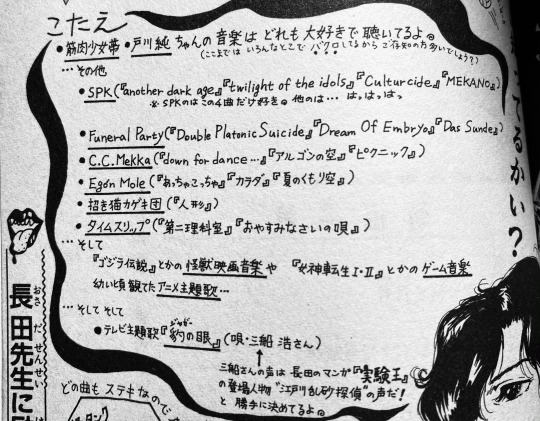
Moon Age 15 was originally printed in 1988 as a two-part miniseries in the horror magazine Complete Collection of Horror and Occult Works - HELP, namely in volumes 5 and 6. While being an early work that derived from the TGG, it still wasn’t the first comic to adapt the Litchi stage play, with Das Blut : Blood and Eternal Girl preceding it with their 1986 publication in Osada’s debut anthology Night Reading Room, sharing the same year as the TGG’s early closure following creative conflicts between Norimizu Ameya and K Tagane (the group's author, who remains anonymous to this day). It’s to be noted however that while Das Blut and Eternal Girl were the first stories to feature the Hikari Club as antagonists, they are only tangentially related with Moon Age showing more distinct Grand Guignol archetypes (musings of the full moon, examinations of the Hikari club’s misogyny, idealization of technology, and even an early rendition of the Litchi robot itself). First kept solely as a brief serial, Moon Age was later reprinted in abridged form as a short story in the 1996 Blind Beast anthology.
While copies of HELP are notably hard to find and demand high prices, I was given an in depth view of both volumes that featured Moon Age’s serialization by a collector earlier last year. While the drawings are still the same on a rudimentary level, the length of the serialized version is notably longer than the later Blind Beast variant, with the HELP serialization being over 40 pages while Blind Beast’s is only 24. This was the product of the manga being entirely revised for Blind Beast’s print, with the layouts being drastically altered along with basic revisions of the line art. Certain scenes that would usually take 2 to 3 pages in the HELP version were condensed to 1, resulting in a unique tradeoff where one version feels unusually spacious in its framing while the other is heavily condensed and almost chaotic by comparison. It’s only a thing that springs on you once you compare the two variants, I saw the revised version first and originally didn’t pay any mind to it.
One thing that is certain is the polishing of the art. The brush work in the Blind Beast version is refined with a more elaborate sense of weight and flow while the HELP version is notably rough with the prominent use of rudimentary screentones. It reflects as a somewhat rougher variant of the art shown in Night Reading Room. It feels strangely digital, like it’s the product of early computer art. The line-by-line reuse of the decapitation scene from Eternal Girl being shown on the TVs further adds to the strange digital feel of the art style.

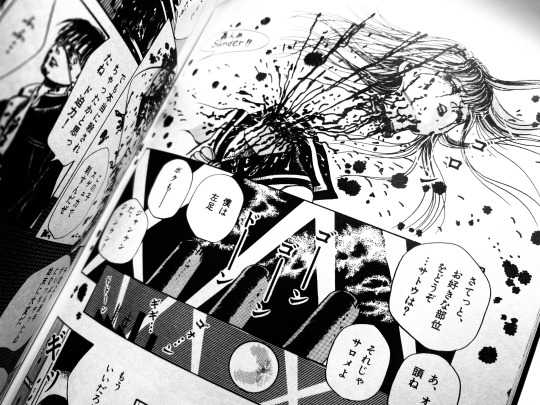
Similar to Moon Age, Osada's other stories of the Hikari Club featured the members luring girls to their brutal deaths. In Eternal Girl the members bring in a student and film her mutilation for a snuff film that acts as the story's namesake, in Das Blut they corner another student to the woods where they hang her, and in Jinta Jinta they kidnap a student who bullied one of her classmates to suicide before trepanning her with a strange device that's somewhere between an electric chair and a drill.
Not Osada was very recently namedropped in the concluding essay of an English print of Kawashima Norikazu’s Her Frankenstein under the alternate Nagata Nooto anglicization of Osada’s pseudonym. Their name is a curious case as while there is a prominent written variant (長田ノオト), it’s seen numerous English iterations. In Osada’s own English signatures it is written as Not Osada (with the name apparently being derived from a German phrase), but other variants include Osada Nohto, Osada Nooto and Not Nagata. If I'm not mistaken, it could count as one of the first English acknowledgements of Osada's works in print.
45 notes
·
View notes
Text
Cut the (Ghenea) crap
I have been anticipating since at least last Friday the very recent rumor overdrive about S and Mrs. Mădălina Ghenea, Romanian Horizontal Extraordinaire and I howled like a pack of hyenas in the dull silence of my flat.
Of all the rumors featuring S and divers representatives of the International Fitness Harem, this one stroke me as the most ridiculous ever. Downright scraping the bottom of the barrel, here, to be honest.
Now, as all of you know, I happen to be Romanian and if anything, you should at least grant me the benefit of a flawless knowledge of the terrain, so to speak. And as far as erotically ambitious Romanian chicks go, let's just say I am a sweet summer child, compared to this one.
Mădălina hails from Slatina, a small town in Oltenia, one of the most fascinating parts of the Romanian Southwest (I have a good quarter pint of Oltenian blood myself, so I think I know what the hell I am talking about: quick-witted, ambitious people, with a devastating, sarcastic sense of humor). She comes from virtually nothing: a working-class family of former farmers drawn to the nearest town by the quick and demented industrialization of the country during the Sixties, which is to say, the Lumpenproletariat our German friends can immediately relate to. But when you spend your childhood in the dull and poor anonymity of a non-descript block of flats (matchbox upon matchbox upon matchbox - think of it as a dignified favela of sorts), the only thing you want to do is to get the damn out of there, at all costs. Which, I have to say, she brilliantly and ruthlessly managed to, almost in record time. Granted, she is beautiful (to me, she is very cliché, but for any foreign male she is a Wanton Goddess of Sex, I suppose) and she does have the street smarts to safely get her through any urban jungle of this planet, too.
You can peruse her war credentials here, for a quick overview of the character, if you really, really, really need to: https://en.wikipedia.org/wiki/M%C4%83d%C4%83lina_Diana_Ghenea.
I will just add (and you will have to trust me on this one), a couple of things:
Cynically speaking, she could be a decently plausible beard for S. After all, she did beard for di Caprio (an info I just corroborated over the phone with a friend who is a cinema & TV journalist, back home). Problem is, a woman like this is way over budget. I am afraid The Boy doesn't qualify, bless his heart: too meh for her eclectic, but high-end tastes (local cardboard millionaires, Bulgarian tennis players of the light mafioso type, Philipp Plein, Italian TV beaux and yup, Gerard Butler - but it did not end amicably, enough said). You have to understand that woman saw it all and she won't settle for a pap walk in the pishing drizzle of GLA, or even NY. This one knows perfectly well diamonds are a girl's best friend. And if you doubt me, maybe you won't doubt her, when she declared three days ago for the Daily Fail something along these lines:


[source, LOL: https://www.dailymail.co.uk/tvshowbiz/article-12681539/EDEN-CONFIDENTIAL-Sexiest-woman-world-Madalina-Ghenea-yearns-real-man-stealing-hearts-Leonardo-DiCaprio-Gerard-Butler-Michael-Fassbender.html]
Read my lips: not going to happen. Not in a million years, not even for the sake of the fucking Narrative. Not even on a desert island. Never. Nuh-oh. No way.
At any rate, if God knows what sick plot twist happens, you'll learn it here first, probably: the Romanian gossip press would put to shame poor Deux Moi, with its needlessly chatty, exuberant, salaciously detailed style.
So I will say again here what I did say in a comment to an Anon who brought it up first @bat-cat-reader's :
TERMINAȚI CU TÂMPENIILE. Which is simply translated as CUT THE CRAP.
Of course.

99 notes
·
View notes
Note
Feel free to adapt these in whichever way you see fit in case they’re not applicable :) 2, 20, 24, 39, 43, 51 for the ask game!
Thank you 🥹🤗 No issues with answerability
2. Where do you get your fic ideas?
The Muses shoot ideas into my head and my body becomes a mere vessel.
Sometimes I get inspired by other media and tweak their ideas and see how that works. Pretty often though, I just think about the things I'd like to see in fics and go from there.
20. Do you prefer writing AUs or canon fics?
I'm dancing on canon's grave.
Well, most of the time. My Winx rewrite is my sandbox and my focus is on Domino and the related characters, and since my interpretation of events, plot points, the magic system et cetera differs so much from canon, I'm firmly in the AU camp. That said, I sometimes write pieces that are vague enough to be canon compliant.
24. How do you choose whose POV to write in?
Most of what I write has very clear central characters, so I never really struggle with choosing the POV. Whoever has the most relevance to the events of the chapter will be the POV character. Let's say the Company of Light are discussing Valtor, then Griffin will most likely have the stage. (My multichapter Domino prequel will never see the light of day. I haven't written anything down, but I've certainly Thought about it 😆)
Sidenote, but first person is so unbelievably difficult to write in. Third person limited my LOVE
39. What’s your most self-indulgent wip?
The one where I smoosh all my favorite things together, of course.
Daphne is a major character in my Season 3 rewrite, and it features a plot point where her own magic is turned against her - she's put in an enchanted sleep. I was inspired by the episode Rapunzeltopia in Tangled the Series, as it uses a similar setting. Pending title The Lady in Gold.
It stars Daphne in her spirit form, as a warrior-guardian to an amalgamation realm of Magix and Domino. She's simultaneously venerated above other people and expected to give all of herself for their benefit, and as a spirit, she internalizes that role. Once she meets her subconscious self, it forces her to confront the things she's kept buried since she first appeared to Bloom - the anger at the people dehumanizing her, the despair at the Fall of Domino and everything she lost in consequence, the hatred of the people responsible, the desire to live the life that was stolen from her. Bit by bit, the illusion lifts and the dream shatters.
The sequence plays out like a fairy tale, in narrative style and general mood. It's a character study as well as a turning point for her. She comes out of it changed, and I don't just mean as a person, but also ✨plot reasons✨
43. Is there a trope or idea that you’d really like to write but haven’t yet?
Platonic soulmates! And I have no idea why I haven't written it yet, because I go verifiably insane over this trope. I don't mean magically predestined soulmates, but rather the people the characters choose to love and connect with. The kind of relationship where the characters bring out the best in each other, and complete and contrast one another as best friends/family is. My. SHIT
51. Does what you like to write differ from what you like to read?
The scope of what I write is pretty limited, as most of it is character studies or snapshots of their lives. That's also what I gravitate towards when reading, but far from the only thing. Show of hands if you love a good adventure longfic, par exemple. 🙋🙋🙋
21 notes
·
View notes
Text

Zayn Malik Writing New Music for Animated Feature ’10 Lives,’ Will Duet With ‘Bridgerton’s’ Simone Ashley (EXCLUSIVE)
Zayn Malik is writing new music for upcoming animated feature “10 Lives” and is set to perform a duet with “Bridgerton” star Simone Ashley for the film, Variety can confirm.
Malik and Ashley also both star in the film, with the former One Direction singer playing tough-guy twins Cameron and Kirk while Ashley voices student Rose. Malik, who is currently working on his next studio album with Mercury Records, is also an executive music producer on “10 Lives,” overseeing the film’s musical creative direction.
Directed by Chris Jenkins (“Surf’s Up”), “10 Lives” tells the story of a pampered and selfish cat who takes his many lives for granted. After carelessly losing his ninth live he begs for a second chance — and an opportunity to prove he can learn from his mistakes. When his wish is finally granted, however, he learns that it comes with some caveats.
Also lending their voices to the film are Bill Nighy, Mo Gilligan, Sophie Okonedo, Dylan Llewellyn and Jeremy Swift.
“I always enjoy my time in the studio creating from my perspective,” said Malik. “While creating music for ’10 Lives,’ I was able to immerse myself in a narrative that I hadn’t dictated and able to bring the characters’ emotions into the music rather than my own. I really enjoyed writing specifically to bring them all to life. It’s a film that’s not only fun to watch but has a very beautiful sentiment for people of all ages. I hope people love it, and the music we created really connects and transports them deeper into the ’10 Lives’ world.”
Guy Collins and Sean Feeney produce for 10 Lives Prods. alongside Martin Metz and Adrian Politowski for Align, Yann Zenou for Quad, Valérie d’Auteuil and André Rouleau for Caramel Films and Louis-Philippe Vermette for the Happy Producers. Robyn Klein and Jeremy Ross cast the project while the animation was produced by L’Atelier Animation in Montreal.
“10 Lives,” which will screen for distributors at AFM, is a GFM Animation production; GFM is also handling international sales. WME Independent is repping domestic rights.
Casting directors and music supervisors Robyn Klein and Jeremy Ross said: “We always love bringing the worlds of film and music together and could not be more excited that we got to do this with Zayn on ‘10 Lives.’ A great film and a great song come from the same place. Combining his songwriting, acting and vocal skills, Zayn brought joy, emotion, and depth to the film while connecting and highlighting all of its important themes. This is Zayn at his absolute best.”
Malik is repped by Nicola Carson of Zen Kai Management and Taryn Zimmerman. Ashley is repped by Creative Artists Agency, Identity Agency Group, R&CPMK and Myman Greenspan Fox Rosenberg Mobasser Younger & Light.
VIA VARIETY
74 notes
·
View notes
Text
LDS LGBTQ Anniversaries for 2023
For 8 years I’ve been in charge of creating my stake’s calendar. In addition to stake meetings & activities, I include holidays and significant LDS anniversaries like when it was the 175th anniversary of the founding of Sunday School or 40 years ago priesthood and temple blessings were restored to members of African descent.
This year there's only 1 significant anniversary I put on the calendar: Sept 21st will be 200 years since the angel Moroni first appeared to Joseph Smith.
For readers of this blog, here’s a few anniversaries this year that may be of interest:
75 years ago
April 1948 - Gay BYU students Kent Goodridge and Richard Snow met with church president George Albert Smith. They were in love and wanted to get a clarification of their ‘status.’ President Smith treated them with great kindness and told them to "live their lives as best they could" in their companionship. They had gambled making this appointment and worried they could be excommunicated on the spot, instead they left feeling loved and valued.

Unfortunately, this live-and-let-live attitude didn’t last long as President Smith's successor, David O. McKay, felt homosexuals "should be excommunicated without any doubt, that the homosexual has no right to membership in the Church."
30 years ago
May 18, 1993 - Apostle Boyd K. Packer gave an address to the First Presidency, the Quorum of the Twelve, and the Presiding Bishopric, in which he stated there are three great threats to the LDS Church: the gay/lesbian challenge, the feminist movement, and scholars
September - The September Six are excommunicated for publishing scholarly work against or criticizing church doctrine or leadership. This was widely reported in national press and resulted in a chilling effect on academics challenging approved church narratives

25 years ago
October - Mormon-raised Russell Henderson and his friend Aaron McKinney tortured Matthew Shepard and left him for dead in Wyoming. The shocking crime made international news. The outrage over this crime eventually lead to the Matthew Shepard Act in 2009 which expanded the federal law’s definition of “hate crime” to include sexual orientation and gender identity. In 2018, Matthew's ashes were moved to the Washington National Cathedral

15 years ago
Chieko Okazaki, the first person of color to serve in an LDS Church general organization presidency, was first counselor in the General Relief Society President when she published a book in which she wrote “A family with a gay child is not a failed family. It's a family with a member who needs special love and understanding and who has love and understanding to give back.”

California’s Prop 8 - Church leadership heavily encouraged members donate time and money to pass Prop 8 which would ban same-sex marriage in California. About 1/2 of the money raised for its passage came from Mormons. The proposition passed and immediately there were protests at temples in Los Angeles and Salt Lake City, and the church received a lot of negative exposure. Since then the church has preferred behind-the-scenes roles in its efforts to combat queer rights
10 years ago
Dec 20, 2013 - Same-sex marriages became legally recognized in Utah. Seth Anderson & Michael Ferguson, both former Mormons, are the first gay couple to get married in Utah

5 years ago
January 2018 - The documentary "Believer" featuring Imagine Dragon's lead singer Dan Reynolds premiered at the Sundance Film Festival. Reynolds discussed the intersection of LGBTQ people in the Mormon community. Later in the year he appeared on The Ellen Degeneres Show and The Daily Show with Trevor Noah and spoke of LGBTQ Mormons and suicides
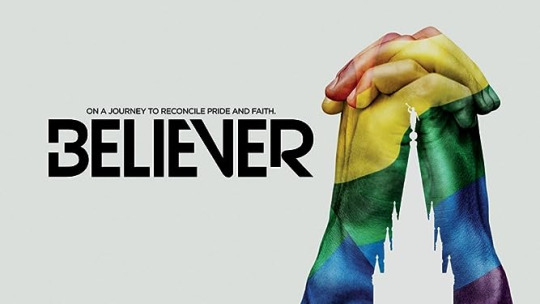
January 2018 - Josh Weed, the most famous LDS gay man in a mixed-orientation marriage, announces that he & his wife will get a divorce. They apologize to everyone who ever had their story held up as an example that gay people can get married and stay in the Church.

February 2018 - Church-run Family Services states it no longer provides reparative therapy or sexual orientation change efforts
February 2018 - Richard Ostler starts a podcast called “Listen, Learn, and Love,” which has LGBTQ members/former members share their stories

March 2018 - BYU sponsors its first LGBT campus event, a panel of four students--Kaitlynn Wright, Ben Schilaty, Sarah Langford and Gabriel Cano–answer student-submitted questions
As president of the LGBTQAI+ and Allies Club, Jill Stevenson worked with administration at Southern Virginia University, a predominantly-LDS liberal arts college, to get the university to officially recognize the club, and to allow same-gender dancing on campus
June 2018 - The Church’s Family Search website starts allowing same-sex marriages to be recorded
July 2018 - The Provo Freedom Festival allows LGBTQ groups to participate in the parade due to a contract it had signed with the city of Provo which included a non-discrimination clause.
Dec 2018 - Stacey Harkey, a cast member on BYUTV’s popular show Studio C, comes out as gay

103 notes
·
View notes
Text
Over Casca’s naked body
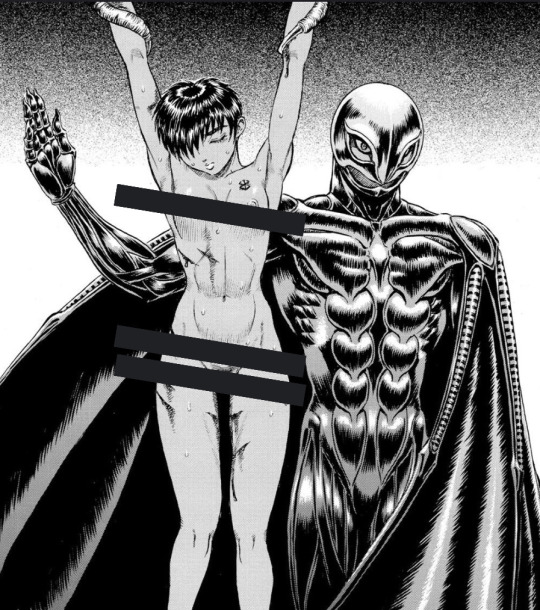
Part one: A long premise
We can’t escape from our geopolitical context even when we are reading manga. We have internalized a good amount of beliefs, values, practices, even regulations from our lived experiences and various simulacra we have been exposed to, especially those in an audiovisual form.
If you grew up in the US, you know that freedom of speech is a core value there. But, while you can say mostly whatever you want within your own country, the US constitution has given the government the right to regulate what comes in from abroad. [1]
And that power has been used. Idealistically, greater access to common technologies even before the internet should have seen a redistribution of the media-creating capacity to many foreign countries outside of the US, so that people could tell their stories. But that hasn’t always been the case, with some exceptions, especially if we consider the biggest narratives that reached global popularity.
During the Cold War, anything that might be considered “communist propaganda” could be seized by the Post Office and never delivered. Books or even souvenirs from communist countries, for instance. Pamphlets criticizing US foreign policy. (…) Obviously it wasn’t totally like North Korea, plenty of foreign movies and music were allowed into the US. But the media that caught on was either already Americanized, or so plastically exotic that it doesn’t really say anything about the culture where it is from. The Beatles were British, but they got their start covering American rock and roll musicians. When John Lennon stepped out of the line, the American government made sure that he knew it. Movies imported from Japan were mostly samurai flicks, with very few movies set in the modern day. The film Ikiru is widely considered the best Japanese film ever made (…) but this existential drama about a depressed lonely man was only given a limited release in California, and the poster was edited to feature a stripper who is only in the movie for one minute. The narrow stream of European movies that made into the USA came in the form of the French New Wave cinema, movies that were stylistically inspired by American films, but also so stuffy that few audiences would ever want to watch them anyway. This was further stifled by the Hays Code, a set of extremely strict regulations that were in place from 1934 to 1968. (…) Some things that were completely banned from ever being shown in any film included: bad guys winning. All movies must end with the police outwitting the evil criminals, or the criminals causing their own demise. Any nudity. (…) Blood or dead bodies. (…) Interracial couples. White people as slaves. Criticism of religion, or of any other country. Naturally this prevented the more artistically liberal European films from being shown in American cinemas and when they did get a release, they were usually edited (…). At least until the rules were abolished in 1968 and replaced by the age rating system we have today. [1]
Even after several decades of access to the internet and foreign cultures, some attitudes have been internalized and carried on. For example, I had direct experience of the ways my own culture has been perceived and stereotyped or interpreted in terms not dissimilar from the exotic. And the same happens to me probably if I don’t keep in check my own personal beliefs about cultures that have been presented to me in similar ways. And I was surprised to see by how deeply rooted and spread are certain attitudes towards punishment or violent retribution viewed as necessary, the policing and self policing, and the expression of judgments or condemnation, and all this can complicate the understanding of different forms of narratives and the acceptance of different cultural attitudes and norms, without the expression of any opinion about morality or legitimacy.
I am reminding you that this is a long premise because I evidently don’t have the gift of brevity but this article is about Berserk and Casca.
In 1956 Anna Magnani won the Academy Award for Best Actress for her first English-speaking role in the American movie The Rose Tattoo. In 1958 Miyoshi Umeki was the first Asian born actress to win an Academy Award for Best Supporting Actress in Sayonara, a movie that despite its title was an American drama starring Marlon Brando. It isn’t hard to see in these decisions from the Academy, or the ones that followed in other categories, the willingness to build relationships between the US and specific foreign countries where the American army had a massive presence and that after WWII were ideal places for American investors, considering significant rebuilding necessary after the loss in the war. The movie industry and everything around it had instrumental roles. When it comes to the Academy Award, it is very interesting to notice that the women were the first ones to be nominated, becoming ambassadors and facilitators of the reshaping of the images of Italy and Japan from enemies to new essential strategic allies in the Cold War. And here comes the problem of the exotic, because after several decades I still see similarities in the American perception of those foreign cultures, Italian and Japanese, to those easy and friendly and intentionally constructed imaginaries of that time. Take the press around Anna Magnani or Miyoshi Umeki for example. Terms are so widely used and repeated that they are still in their Wikipedia pages in English today. For what interests me here, I am going to quote or summarize parts of the video essay listed below as [2] but I really recommend watching it entirely. It really helped me understand some of the issues I am talking about here, but it is much more than just this. And there is footage worth the time.
[I know that many people here on tumblr really dislike YouTube videos. I understand why, when it comes to manga and anime, written articles have still better quality and content, in my opinion, but there are also many video essayists doing their due diligence on several other topics. And when I am busy cooking I put them on].

In the 1950s one of the problem with the new alliance with Japan was the widespread hate and racism towards Japanese people.
The government stepped in, producing educational films meant to endear Japanese culture to Americans (…) They showed off Japanese industry, introduced Americans to sushi and sumo wrestling, explained the country’s new democratic system et cetera. (…) A lot of [musical] acts that were popular with American soldiers, specifically exoticized Asian girls bands, like the Kim sisters and the Tokyo Happycoats, come over to the US and appear on television as both entertainment and a sort of cultural ambassadors, not only demonstrating America’s cultural power and dominance by performing recognizable American tunes, but also signaling to white Americans that those cultures didn’t pose a threat. (…)
It’s worth looking at this film [Sayonara] as part of a larger theme in a very specific post war moment. Gina Marchetti points out in her book Romance and the yellow peril: «Between June 22, 1947, and December 31, 1952, 10517 American citizens, principally Armed Services Personnel, married Japanese women. Over 75% of the total Americans are Caucasian». Meaning, Japanese war brides and the concept of interracial marriages was very much a conversation. (…) Sayonara must be seen as one of many films which called for a new evaluation of Japan as an enemy nation. (…) Much of the way [Miyoshi Umeki] was discussed is probably exactly how you might expect. The language journalists used to describe her was unambiguously racialized and often condescending. In the aftermath of her Oscar win, for example, Louella Parsons called her «a lovely little bit of Japanese porcelain», adding: «What a cute little thing she was in her native costume». Still, her Japanese identity also seemed to serve as a symbol, an embodiment of the new friendly Japan. In Miyoshi, Americans would find an idealized portrait of reconciliation, a woman who bore no resentment over the war, a woman who brought homesick American troops to tears by singing White Christmas, who adored American pizza, who learned English by listening to American records. She was accepted because she actively appreciated and participated in American culture. [2]
The roles offered to Miyoshi Umeki are significant in many ways. After Sayonara, she was cast to play other Asian characters besides Japanese ones. One recurring theme in those movies in particular is the contrast between modernity and tradition.
William G. Hyland writes, Flower Drum Song is a «clash between the Americanized lifestyle of the young Chinese and the traditions of their parents». (…) Miyoshi Umeki plays Mei Lee, a Chinese stowaway who arrives in the US for an arranged marriage. The more Americanized she becomes the more independent, the more willing she is to strike out on her own. [Chang-Hee] Kim writes: «[Flower Drum Song] flamboyantly shows that Asians in America were ready and willing to cast off their heritage and become real Americans in repudiation of the pre-war racial consideration of Asians as permanent aliens». I mention this not only because it’s one of Miyoshi’s major roles, but also because this theme, a supposed enlightenment via westernization, occurs again and again in her filmography, particularly in her work on television. Han [?] writes «Umeki’s representation on television is in constant oscillation between her status as a subservient Asian woman and her transformation into an assertive, modern female professional who has achieved independence through American cultural influence». [2]
Bear with me for a little longer if you can, because we are at the point where, watching the video, I experienced that sensation better translated visually in a lightbulb being turned on. I am skipping here the presentation of the story and footage from Miyoshi’s first appearance on television in The Donna Reed Show, but I once again invite readers to watch the video, which features high quality original footage. I was really struck by the “sensitive way” the American woman - Donna Reed I presumed - approaches the character played by Miyoshi, as the writers back then were well aware of the sensitive racial implications, and nevertheless a certain mentality pushes thought. Watching still, it is easier to avoid the presumption that in the 1960s “they didn’t know better” or that contemporary attitudes have improved greatly, just because we are more careful about the language we use.
The thesis statement of this episode is not subtle. The rejection of traditional Japanese customs allows her to live more fully in a democracy. Of course it isn’t really much of a choice, is it. Maintaining the customs of your culture or risking alienating your entire community. She changes her clothes, puts on a hat and goes shopping because she is an American now. Obviously these stories are told from the white American perspective, where this rejection of tradition and culture is portrayed as unambiguously positive and relatively tension free. This was not the case in Japan where the relationship between modernity and tradition were richly explored in cinema, particularly in women’s films. [2]
I would like to add that the independence that Donna’s character shows is only possible because of a series of factors, including the fact that her husband secures her a higher level of comforts, in comparison with lower classes or non-white Americans, and that domestic work is presumably done by home electrical appliances or other women, especially when you add child care and looking after the elderly to the equation. The unwillingness to consider those types of labor, traditionally carried on by women, as of equal importance to any other jobs is rarely discussed when it comes to the issue of women’s emancipation. Not to mention how, alongside this idyllic world shown on television, in the same country large numbers of women have to deal with continuous push backs in the name of different traditional values that all the same prevent many of them from achieving true equality. Those types of conversation and conflicts between traditional and modern happens at the same time in many countries and in most cases translates to continuous negotiations and compromises carried by men and women in real contexts and real situations, without necessarily white American women being aware of it or of all the necessary nuances.
Let me add this last element of conclusion about Miyoshi Umeki’s story.
In 2018 her son told Entertainment Weekly that in the 1970s she etched out her name on her Oscar and then threw the trophy away. Although he isn’t sure exactly why she did it he said: «She told me, I know who I am and I know what I did. It was a point of hers to teach me a lesson that the material things are not who she was». What Miyoshi Umeki achieved is pretty remarkable but one can’t help but feel that she could probably have done a lot more if she’d been allowed to move beyond her identity. [2]
Part two: Are we reading the same manga?
After considering all this, and more that I can possibly include in here to avoid this being even lengthier, I can’t help but wonder about the generalizations I have seen repeated vastly about portrayals of women in Japanese media, as well as misunderstanding of cultural attitudes towards nudity or the treatment of sensitive topics like sexuality and rape. There is a diffuse certain sense of entitlement, sometimes you can hear a condescending tone even, and this isn’t limited to the US. But why approach a foreign culture with a patronizing attitude instead of trying to understand the context more deeply? So many manga readers are willing to ask for clarification on translations, but not many ask about the context or the visual aspects involved in manga writing. I like to read analysis about different topics, so I look for them in English too because they are very numerous and easily accessible, but when it comes to the critique about the portrayal of women in too many cases I have to click away because of too many bias or that subtle sense of superiority of judgment. Berserk has become easily accessible and more and more popular but it is so greatly misunderstood at various degrees by a lot of its western readers - me included - and I really wanted to understand what is preventing, in most cases, a textual and contextual analysis.
The Hays Code hasn’t been around since 1968 but the sentiment that the only proper conclusion for every story is the triumph of the good guys and the punishment for the wicked is very much alive and well. There is this conviction that the only clever readers are those able to separate the heroes from the villains, or the good deeds from evil, and root for the right side to achieve retribution and satisfaction. The Hays Code hasn’t been enforced officially but it’s there in essence and every counter narrative has been rendered almost ineffective or judged poorly. As for the treatment of women, I don’t feel like we can honestly and surely compare or scrutinize Japanese media under special lenses. Nudity in comic books seems to me to be very common outside of Japan too, depending on censorship rules. I certainly notice how frequently Casca is shown naked or has been threatened with sexual violence, but I also notice that she isn’t the only one. The exaggeration of Guts’ muscles and the mutilation of his body are largely put on display. Griffith is intentionally shown fully naked, or completely covered by an elaborate armor, and he is subjected to many threats of physical and sexual violence as well. Charlotte is shown naked, but always in her bedroom, in a private environment or with a transparent cloth or a sheet of some kind to make her nudity different from the occasions when Casca’s body is publicly displayed. I am careful with my own thoughts when I read Berserk, I take the time to analyze my reactions and what I am feeling in these situations. I think that this is the reason that certain books or media are intentionally aimed to adults. I don’t feel a necessity to call to censorship or to give guidance of a moral kind but rather to make the necessary reflections. And I can’t imagine how someone can understand the story without taking their time with it.
Part three: Casca’s rape
In 1973 the animation studio Mushi Production released a film called Belladonna of Sadness. I haven’t seen it yet but I know a little about it and I am planning to watch it when I feel like I can do it without being affected in a bad way. It is well known that Miura remembered this film when he designed the Eclipse. In 1975 Pier Paolo Pasolini directed the film Salò or the 120 Days of Sodom, which I strongly don’t recommend to the casual viewer or anyone who felt even slightly offended by Berserk. Suffice to say that in a particular political climate and in the context of the sexual revolution of the late 1960s, in the 1970s nudity and sexuality were at the forefront of the debate and human bodies were exhibited in a symbolic way that can be misunderstood today without knowledge of the context. Gender expression was questioned and men grew their hair or refused to wear suits or to follow rigid dress codes regardless of their sexual orientation. Sexual acts were considered political acts in ways that aren’t comparable with today for many reasons. The languages, the words and the visuals we use are ever changing and actual for a moment and gone the next one or misunderstood. Many words used by queer people in the 1970s wouldn’t be received well today, because the context has been transformed. For what I understand, in films like Belladonna of Sadness and Salò rape and cruelty are preeminently used as symbols because rape and cruelty presented in a direct visual form effect greatly any type of audience and can’t go unnoticed. The sociopolitical climate in the 1970s, in the middle of the Cold War, was particularly violent, both in Italy and Japan, and the art of the time can be remarkably bleak. [Go Nagai’s Devilman was published between 1972 and 1973, Osamu Tezuka’s MW was published between 1976 and 1978, Takemiya Keiko’s Kaze to Ki no Uta was also published between 1976 and 1984].
Kentarō Miura was born in 1966, he breathed the air and grew up in that same climate and was influenced and informed by it, especially later, when he finds himself as a young man in the renewed bleakness of the 1990s. It is likely that he saw Belladonna of Sadness when he was old enough, when he started to develop the story of Berserk, and after being greatly influenced by Nagai’s Devilman. The number of sources of inspirations that Miura used for Berserk is vast, varied and multidimensional and includes books and novels and films of various genres (historical, fantasy, horror, sci-fi in particular) manga, foreign comics books, and traditional art. It is often pointed out among fans that he was also a big fan of Star Wars. Pop Culture Detective released a very interesting video essay called Predatory Romance in Harrison Ford Movies [3] that brought to my attention many things that I didn’t notice or thought about when I was seeing those films myself as a young girl [I am more or less a decade younger than Miura fyi]. Analyzing Star Wars, Indiana Jones or Blade Runner with particular attention to the relationship between the male lead, Ford, and women is an interesting exercise and helps to re-contextualize our judgment about the treatment of women across different media with arguably less reach than Star Wars. I am not inviting anyone to make comparisons and ranking which is better, or absolve Miura because he was influenced by the context around him as everyone else, but I am asking to let go of the presumption that Japanese media in particular presents problematic attitudes towards women by default. The problems are much more generalized than we’d probably like. Better analysis or methodologies are needed to make a proper assessment, and we really shouldn’t assume by default that manga (for boys and men) equals bad treatment of women.
I hope that someone is still reading after such a long time. I didn’t know how to make my point on Casca without at least presenting some of these considerations. I must say I have understood myself better, having questioned why I was feeling uncomfortable when reading Casca but not offended. I understood that Miura wanted me to feel that way, uncomfortable, horrified, and I can appreciate Berserk better [in particular as a person that wasn’t permitted to live in a female body without a certain type of violence].
As stated previously, I noticed that Casca is more exposed and shown in all her vulnerability in much extreme situations: to multiple men in very public displays, like on the battlefield or at the center of the circle of Apostles in the Eclipse. She is also shown naked and vulnerable in other moments, especially alone with Guts. Those intimate moments with Guts, during the Golden Age, are instrumental for the readers to see her in all her humanity, without the armor, or the female dress, in order to build an emotional connection with her. In the cave, Casca makes herself emotionally vulnerable in front of Guts for the first time and tells him her story, exposing her past, her goals and her true self. She tells him things about Grittith too, things that are meant to show Guts/the readers Griffith as much naked, vulnerable and human as she is. Let’s pay attention and try to recollect Guts’ reactions to her story: he is listening to her, but he is embarrassed, distracted and attracted by her nudity and he fails to see Griffith as a human being, potentially fallible and not much different from Casca or himself. Guts also fails to take away from the story the original message, something more than Casca’s infatuation with Griffith as part of her being a woman. Comparing Guts’ reactions to Casca’s nakedness, his recollections or focus on the conversation, what he takes from it and what he doesn’t: a big part of the male readership of Berserk is probably in his same situation. It isn’t till later by the waterfall, that we see Casca alone with Guts again in an intimate way. This time he is naked and vulnerable and completely exposed too. This time through the physical connection between the two, within the sexual act, Guts can’t hide himself anymore, can’t deflect from his past and his fears. I assume that that is an important moment for the male readership to start to feel emotionally invested in the connection between Guts and Casca. That emotional connection and the investment in the relationship helps them to see Casca as a human being through the Eclipse and if that didn’t work then they still can see and feel the horror of the rape of Casca through Guts. Because Miura didn’t want anyone to enjoy that scene or to be sexually aroused without at least the horror and the moral objection to it.
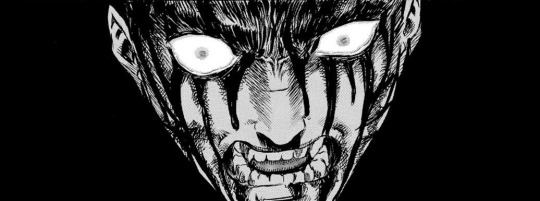
Casca is a woman of color, born in a disadvantaged family and community, that ended up in a mercenary group without achieving the things she wanted, never fully belonging and constantly threatened by groups of men on the enemy side with forms of violence specifically targeted and unnecessary cruel. And everything she goes through culminates or goes back to the Eclipse - before and after - and that should be taken as completely symbolic. Like the multiple instances of rape in Pasolini’s Salò, the innocent, poor and exploitable youth is violated by those in power or those who are in charge. Gambino decides that Guts is expendable or due a lesson in humility, he takes the money and coldly facilitates Guts’ rape. Gennon is rich and powerful and pretends to recreate his fantasy, a sick version of Greek ped*philia. And all he does is using money and power to horrifically exploit the youth and Griffith offers himself up and loses a fundamental part of himself in the process. But the most cruel thing in Berserk is Griffith surrendering to the call of power and doing the same thing to Casca, in the absence of lust or desire: the corruption that has been in him - and has reached Guts as well - has spread. Griffith’s surrender to the call of power, and his intolerance for more of his own pain, silences all empathy in him.
In conclusion, nudity has various narrative functions, beside the suggestion of the erotic: through each character’s naked body, male or female, we see their vulnerability and their fundamental humanity [and if I remember correctly in contrast the rapists are always dressed or covered]. And rape has a symbolic meaning, beside the literal one and the psychological exploration of trauma. Violence but in particular sexual violence is one of the most estreme and powerful tools that can be used in stories [especially in visual media], but unfortunately the overuse of it in an edulcorate format, or as a tease, or devoid of any meaning, has ceased to call for disgust and challenge us to think, has perhaps lessen the impact and the gravity around it. In the 1970s Pasolini saw the dark side of the sexual revolution and how the rich and powerful were willing to build economic empires just to have access to the youth and to the most beautiful women. But he wasn’t the only one. We should reconsider Belladonna of Sadness and the original meaning of those themes in films or later in manga like Berserk and think about it deeply and seriously and not approach every piece of art as entertainment.
Videography:
How America got so Stupid [1]
Miyoshi Umeki: The First East Asian Woman to Win an Acting Oscar [2]
Predatory Romance in Harrison Ford Movies [3]
#berserk meta#casca berserk#manga analysis#this is so long is embarrassing#today we have largely divorced the aesthetic from the political and we look at the last century and don’t fully understand it#editing when I catch a mistake or a misspelled word#eri reads berserk
24 notes
·
View notes